FEATURING
• The Story Behind Trinnov’s Trailers
• Choosing the Right Landscape Lighting Fixtures
• Integration Guide to Whole-Home Audio
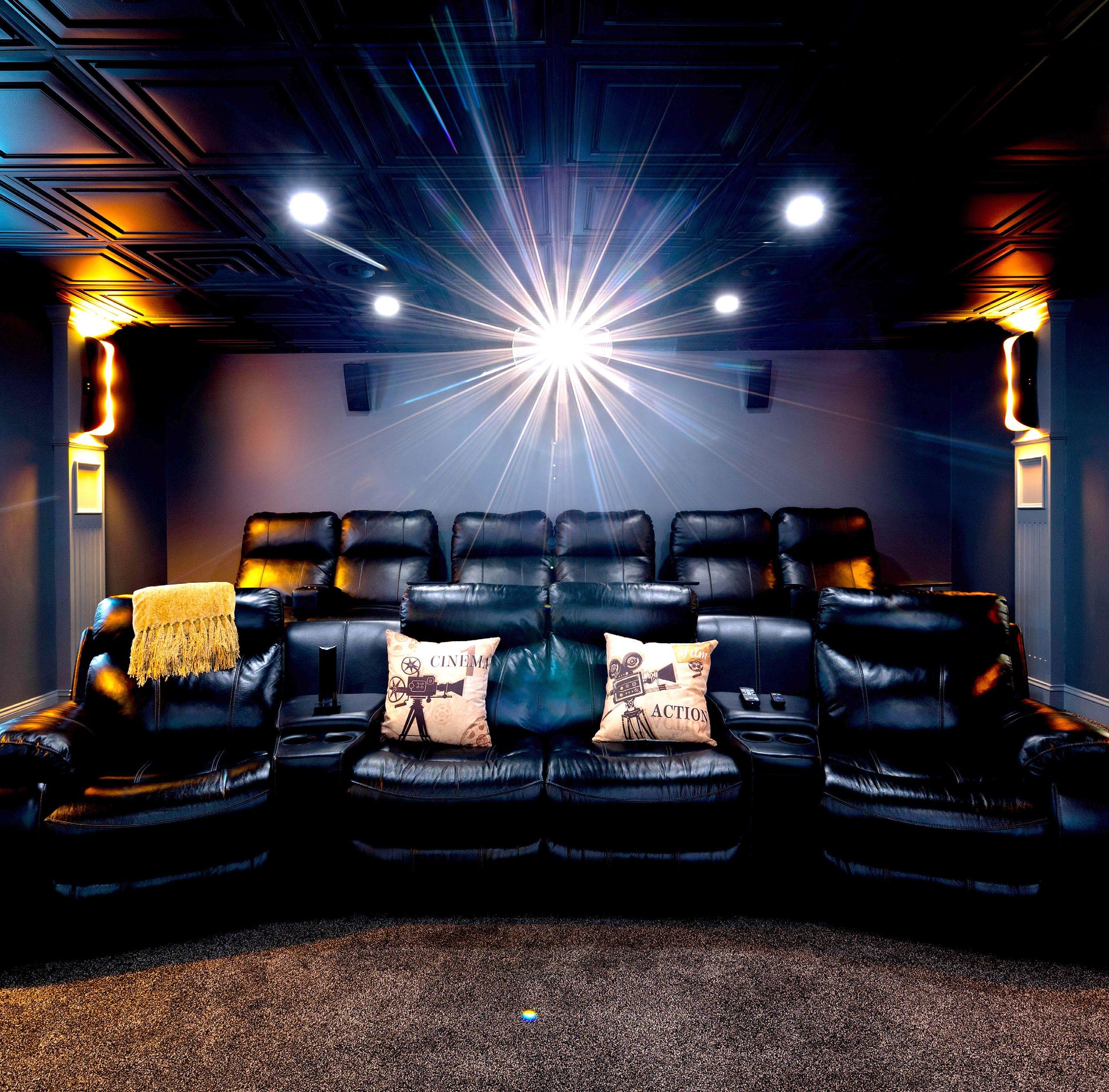

• The Story Behind Trinnov’s Trailers
• Choosing the Right Landscape Lighting Fixtures
• Integration Guide to Whole-Home Audio

Inside Two Private Theaters That Bring People Together
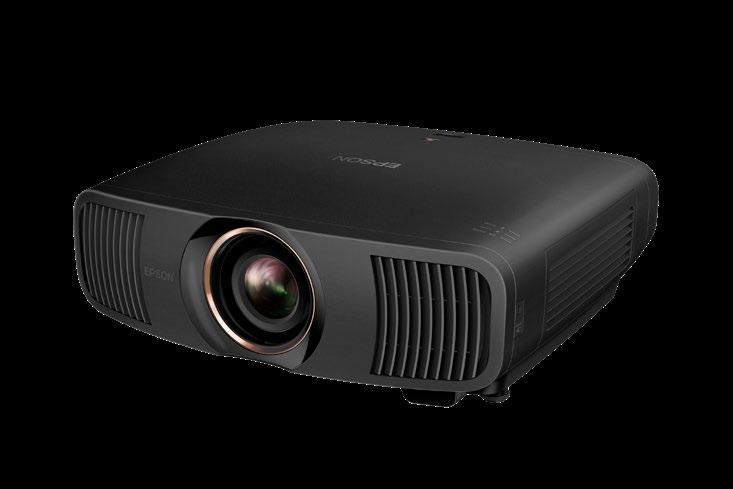
Review: Epson QB1000 4K HDR Laser Projector
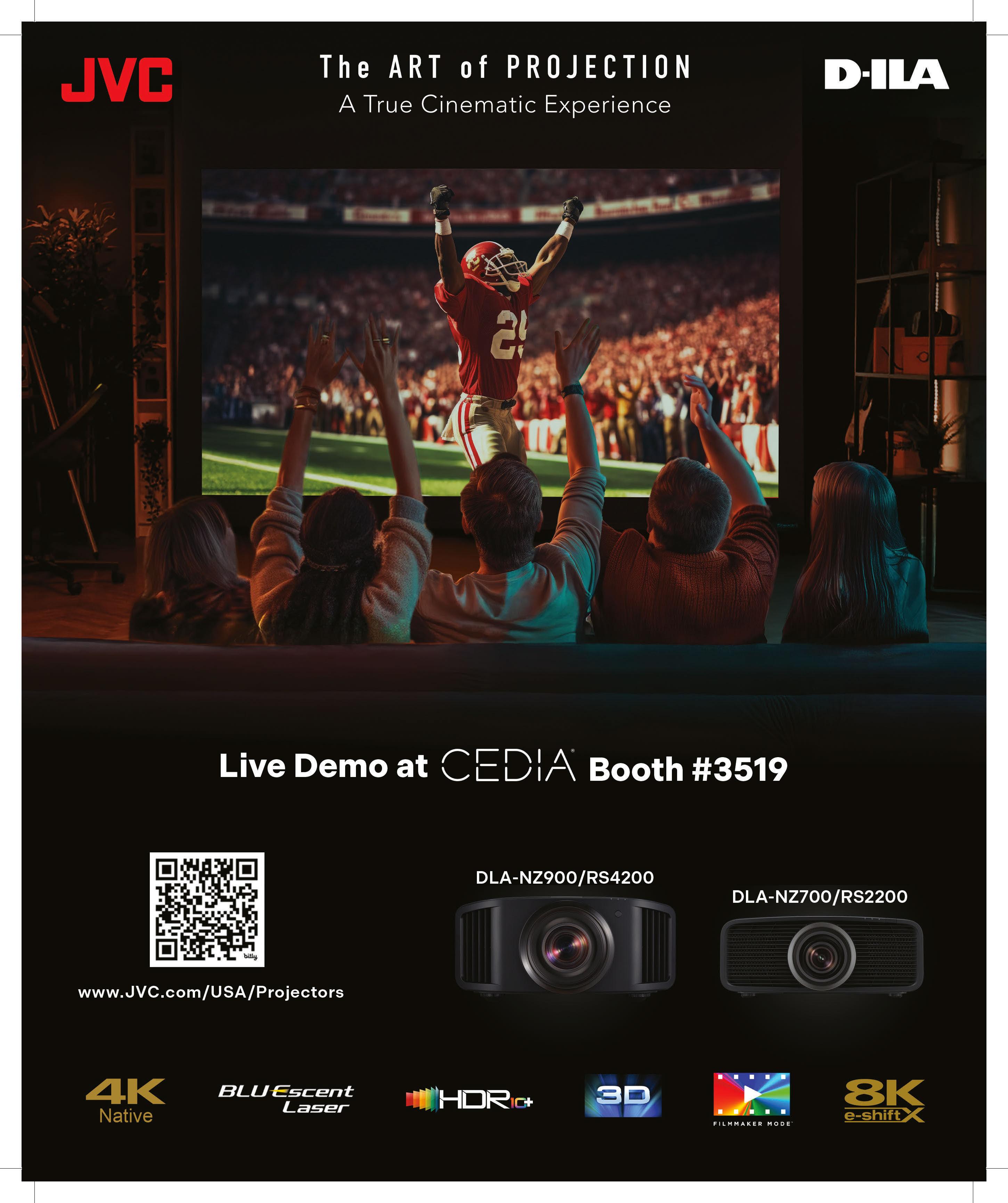
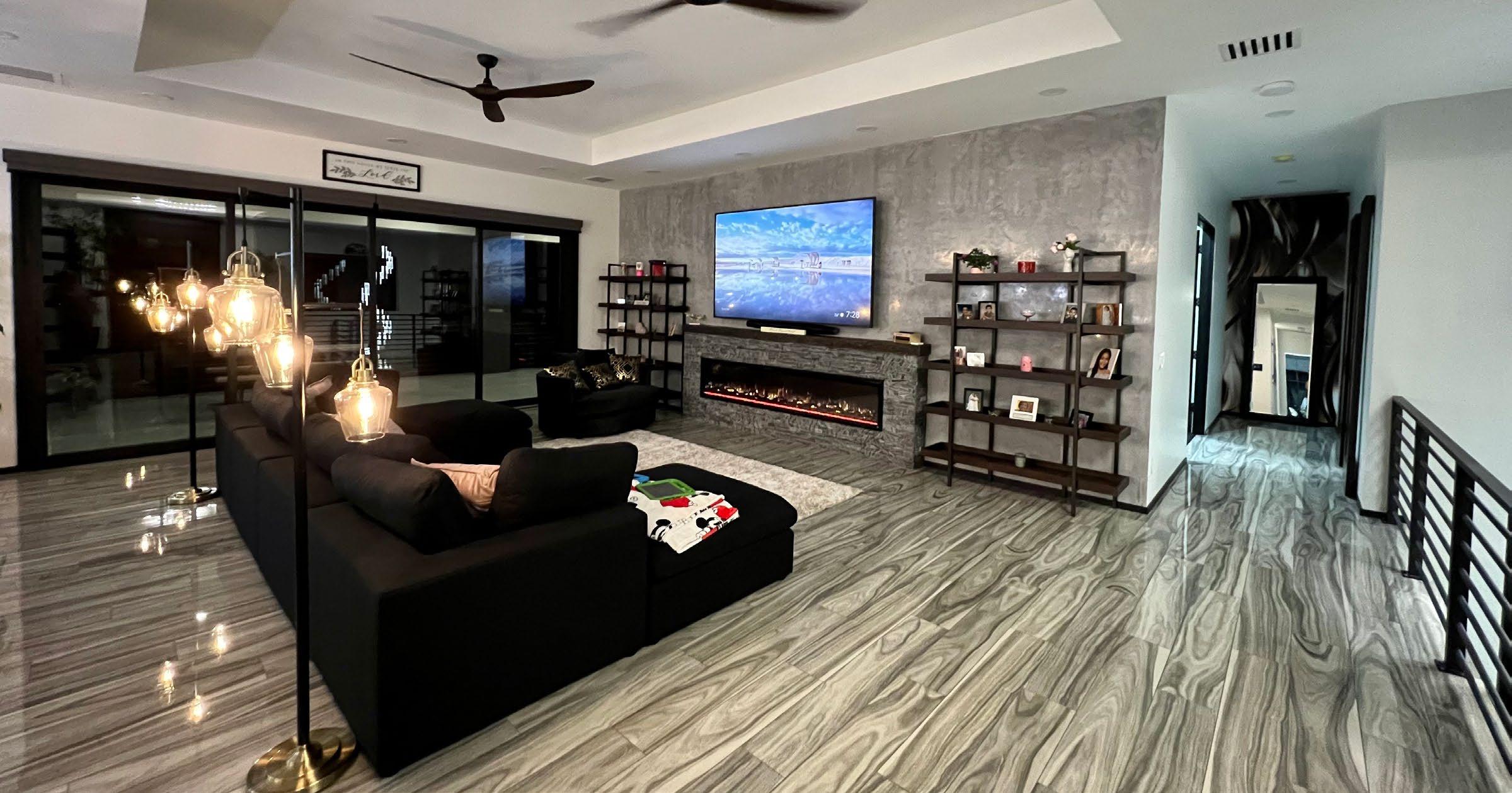
28 Tech Showcase — Lighting Solutions
The lighting solutions product category for the custom installation market continues to grow at a quick pace, offering dealers more and more options for the situations they encounter. Here, we look at some of the more recent additions to this diverse ecosystem, including downlights, tape lights, dimmers, keypads, and many more.
Here’s
By Katye McGregor
Review
For multi-use installations that will be competing with ambient lighting, the QB1000 offers a compelling argument over a direct view display, with images only getting better when the lights go down.
By John Sciacca
The
The
14 Convenience, Comfort, and Community
Certified Sounds helps to create a smart compound on Maui that provides refuge and support in the wake of the August 2023 wildfires.
By Anthony Savona
20 From Boardroom to Big Screen: The Ultimate Dual-Purpose Home Theater Cobb Home Innovations creates a private cinema that doubles as a presentation space for the owners and their employees. By Anthony Savona
Demos That Are Designed to Dazzle Why Trinnov decided to create original trailers that offer a perfect immersive experience.
32 Integration Guide to Whole-Home Audio
All-Enveloping Sound: Today’s whole-home audio products present homeowners with a variety of listening spaces in discreet, flexible systems. By Karen Mitchell Subwoofers and Their Ideal Placement Tips on finding the perfect spot to create the low-end vibe you are looking for.






















BY ANTHONY SAVONA
The Home Theater Issue of Residential Systems tends to be one of the more fun ones to put together because, when I get to talk to integrators about these systems, they tend to get very excited. It is easy to see why — each job represents a calling card for the integrator’s creativity, and the results are a pleasure to experience that often lead to additional projects.
For the two main home theater stories in this issue, there was an unexpected theme that was woven in between the feats of technical prowess. In both cases, the homes were the centerpiece to the clients’ lives, which I know is not unusual, but it can be lost in some of the cases where it is the client’s second or third home, where they spend a week or two each year.
In the case of the Maui home, I had the rare privilege to interview the homeowner in addition to the integrator. Usually, the clients are hidden from me, so I appreciated getting her insights on what she was looking to get out of the home, the process of working with her integrator, and how she was enjoying the results.
It was particularly poignant in that case because the property was near the Hawaii wildfires that took place in August 2023, just as construction on the home was about to begin. Although spared from the flames, the other buildings on the property became a refuge for family and friends who needed a place to stay after the devastation, some opting to remain there permanently. The new home is constantly shared with the community, which makes the homeowner extremely happy. And the home theater is the crown jewel for her, serving as a personal getaway for the family.
And while not as dramatic as the events surrounding the Maui home, the Tennessee home designed by Cobb Home Innovations also had a passionate owner. I didn’t get to speak to the client for this one, but the fact that this home was going to be a centerpiece for his family and also a place for his employees to gather for presentations showed the emphasis that was placed on the space.
This client also had some demands that you wouldn’t expect — like not wanting a rack room and not having speakers on the walls — that offered Cobb the chance to show its problemsolving skills.

But the action that really stood out to me was that, after the home theater room was set up and ready for presentations, the integrator, Hugh Cobb, went back to the client and told him that it looked good for business, but needed to pop more for it to be an effective home theater. The client agreed and, just about a month after setting it up, the Cobb team went back and redid the design of the room — new walls, carpets, and so on — creating a staggering difference.
Sometimes passion runs both ways between an integrator and a client. And when it does, the results can be extraordinary for all involved.


September 2025
Volume 26, Number 9
KATYE MCGREGOR BENNETT
Katye McGregor Bennett is chief strategist and CEO of KMB Communications and an avid podcaster. Podcasts include Connecting Tech + Design and AV Trade Talk.
MATT BERNATH
Matt Bernath is a CE veteran with more than two decades in retail, wholesale, CI, and business coaching. In 2021, Matt and a group of partners acquired VITAL, and Matt now serves as the company’s president/CEO.
GORDON VAN ZUIDEN
Gordon van Zuiden is president of cyberManor, a Daisy franchise and home networking and systems integration firm based in Los Gatos, California.
KAREN MITCHELL
Karen Mitchell is a freelance writer based in Boulder, CO. She has written about the AV industry from both sides now — residential and commercial — for several years and still finds it most intriguing and fast paced.
JOHN SCIACCA
John Sciacca is a principal with Custom Theater and Audio, in Myrtle Beach, South Carolina. In his free time, he blogs prolifically about the CE industry. cineluxe.com
TIM RYAN
Tim Ryan is the executive director and principal lighting designer of Lighthouse Design Studio. Ryan joined Lighthouse in 2015 and has become known for his passion to create mood and magic in illuminated outdoor spaces.









O. Box 1051 Lowell, MA 01853. . Back issues are $8. Copyright 2025 by Future US, Inc. PRINTED IN THE USA.

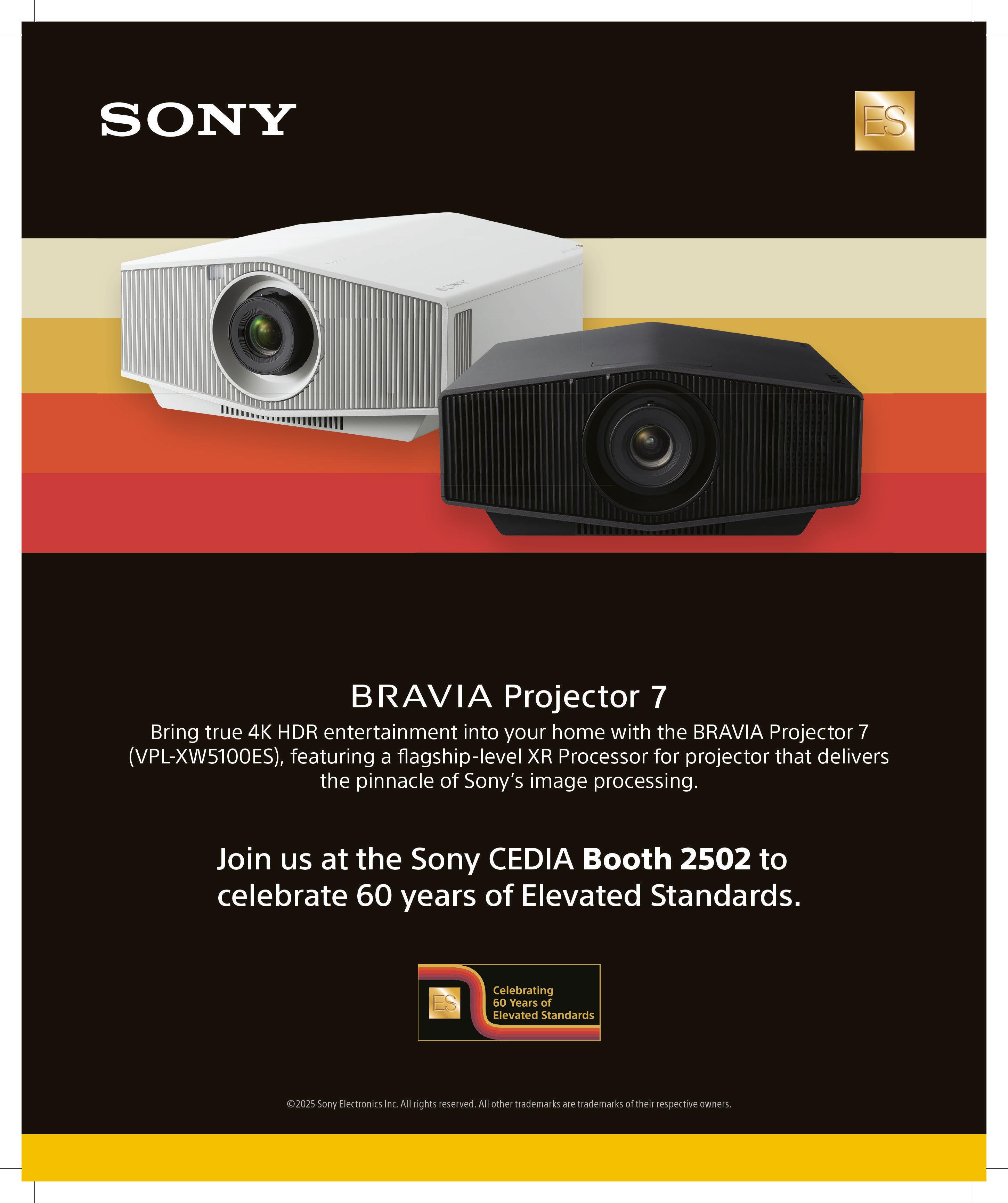
CEDIA examines the growth, trends, and challenges in the professional smart home industry across Australia, Canada, India, the U.K., and the U.S.
CEDIA aims to produce annual market intelligence reports for its key regions to provide the industry with insight into the issues and trends that are driving the industry. For the first time, CEDIA has results from research projects in five key countries, including Australia, Canada, India, the U.K., and the U.S. Figure 1 shows a comparative analysis that examines the growth areas, downward trends, hiring demands, people profiles, and challenges faced by these markets.
In the U.S., 57% of professionals have been in the industry for over 10 years, while 18% have been in the industry for less than 5 years. There are very similar figures in the U.K., with 55% of professionals having worked in the smart home market for over 10 years, and 19% for less than 5 years.
A large proportion of the Australian market – 61% – have been operating in the industry for over 14.5 years, while in Canada, half of the participants have over 20 years, and 19% less than 5 years. There is great experience reported in India as well, with 40% of their integrators having 10-plus years in this industry.
When asked about the most sought-after new hires, the U.S., U.K., and Australia reported that they require technicians to join their companies. In contrast, salespeople are the most sought-after new hires in India.
The survey included a question about whether integrators expect to see their revenue increase in 2024/2025. While in the U.S., 88% of participants said that they anticipated growth, 67% of U.K. integrators, 71% in Australia, and 72% in Canada agreed. India integrators are extremely confident, with 98% of participants expecting growth.
The areas in which U.K. and U.S. participants see this increase are also mirrored:
U.K.
• Luxury market – 77% (increased from 68% in 2023)
• Uber-luxury – 30% (increased from 20% in 2023)
• Mid/mass market – Remained stable U.S.
• Luxury market – 78% (increased from 72% in 2023)
• Uber-luxury – 37% (increased from 16% in 2023)
• Mid/mass market – Remained stable
In the U.S., the market has seen substantial growth in design services and recurring monthly revenue (RMR), while the audio systems and home cinema markets have shown a decline. Similarly, the U.K. has experienced growth in home cinema, design services, and RMR but a decrease in audio and security systems. The Australian and Canadian markets highlight a robust demand for audio, control, lighting, networking, and video systems on projects.
Every country has its own set of challenges, but there are similar trends running through this data.
• U.S.: Operational costs; Product pricing increases; Workforce and labor challenges
• U.K.: Operational costs; Product pricing increases; Workforce and labor challenges; New business growth
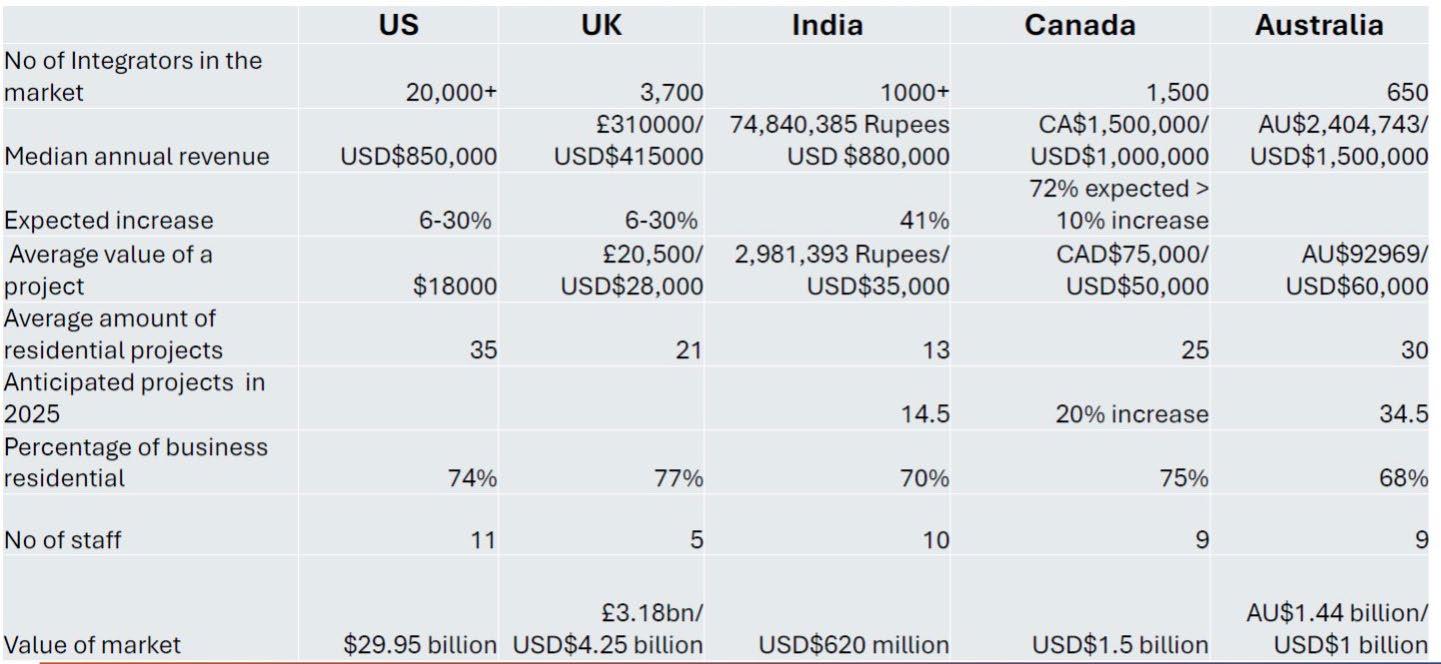
• Australia: Competitiveness in the industry; Consumer awareness issues; Tariffs; Increased freight charges; Grey imports; Manufacturer direct sales
• Canada: Rising costs; Economic uncertainty; Interest rates
• India: Talent acquisition challenges; Professionalism issues; Grey imports
This comparative analysis of the CEDIA market research reports highlights the unique attributes, challenges, and growth opportunities in the home technology industry across Australia, Canada, India, the U.K., and the U.S. With many CEDIA members operating across multiple countries, it’s key for them to understand these insights so that they can better strategize.
CEDIA members can download a free copy of the reports by accessing the product catalog at my.cedia.org.
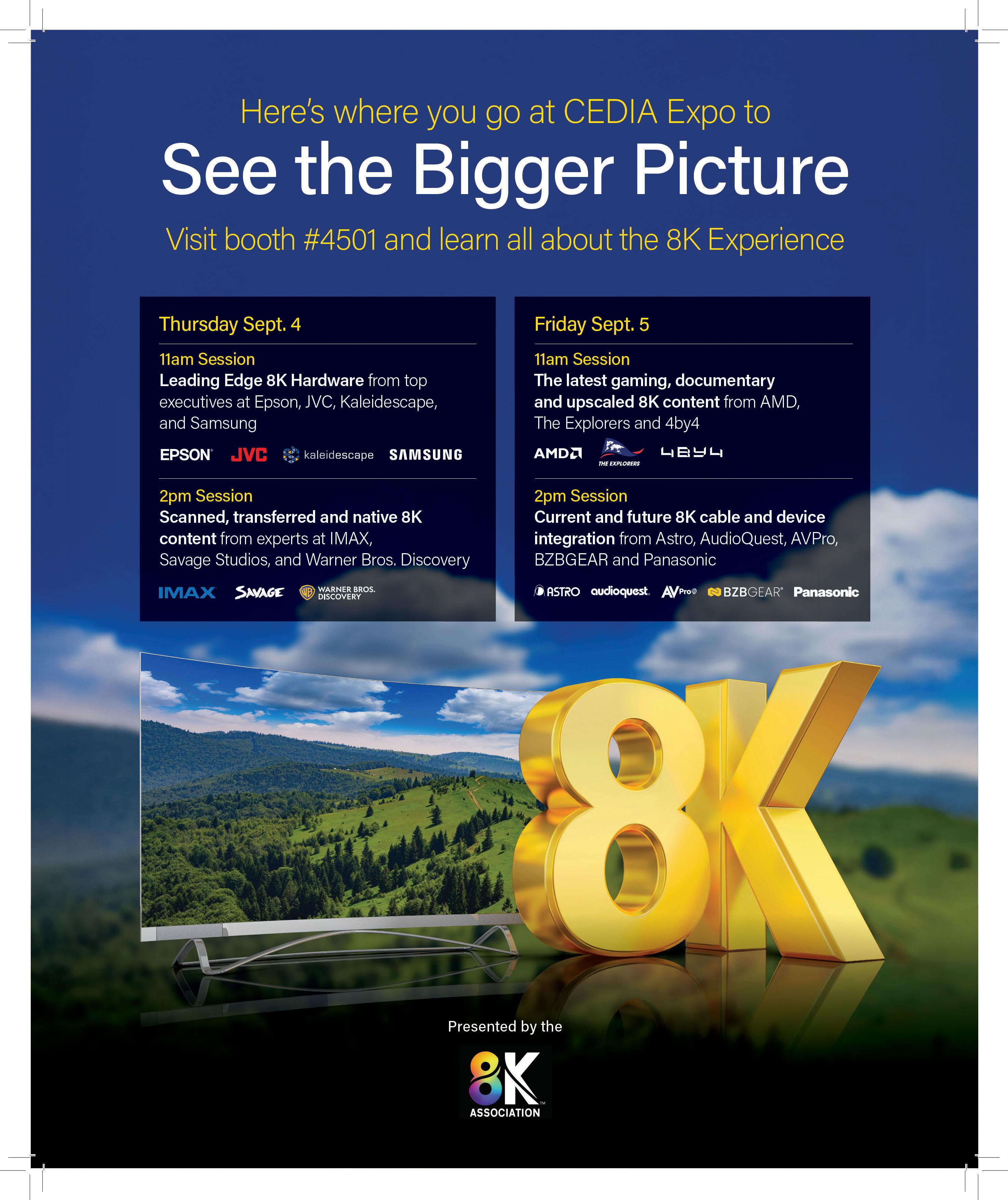
Here’s how to hook attention, spark a connection, and turn casual scrollers into loyal fans.
BY KATYE MCGREGOR BENNETT, KMB COMMUNICATIONS
Let’s be real: The scroll is ruthless. Your beautifully curated living room scene featuring stunning artwork, beautiful furnishings, and carefully placed loudspeakers that you hoped would evoke a sense of luxury and stop people in their tracks? Gone in a nanosecond. That shot of your latest rack build? Scrolled right past. The algorithm doesn’t care how many hours you spend on cable management. It cares whether someone paused. Engaged. Clicked. Shared.
In 2025, social media isn’t just where eyeballs go — it’s where many begin their buying decision journey. And if your content doesn’t stop the scroll in the first three seconds, you’re losing attention (and potentially your next client) to a trending dance, a DIY momfluencer, or, heaven help us, another video of a golden retriever talking to a baby.
But don’t worry — we’re not here to teach you to dance. We’re here to help you stand out.
When it comes to social media, the first frame is your handshake, elevator pitch, and punchline all rolled into one. Whether it’s a Reel, image carousel, or Story, those opening moments are make-or-break.
That’s why scroll-stopping content has one thing in common: a hook.
It might be a funny visual (“When the client ‘sees’ the invisible speakers for the first time”), a curiosity gap (“This lighting scene looks basic... until the sun sets or your favorite team is playing”), or an unexpected moment (your tech brings a client to tears when she realizes she can not only monitor her children’s network usage but also throttle it or disable it entirely if needed by way of a parent-friendly GUI the company developed).
If that last one seems a bit specific, an integrator once told us they now have a client for life and picked several more from word-of-mouth referrals after publishing a Reel that shared a similar story. The client said it showed their firm would go the extra mile and that they truly care about their clients. That sort of emotionally engaging, highly relatable experience sharing is absolutely priceless.
You don’t need a film crew (most of the time). You need moments. In fact, the most engaging content usually feels spontaneous, even if it’s not. Here’s what works:
• Unexpected “explainers”: Showing an intriguing way to enjoy tech in ways you hadn’t thought about before (like the story above, or sensor + app-driven aging-in-place monitoring solutions, for instance).
• Unboxings: Show new gear arriving at a project site. Bonus points if

”You have three seconds to stop the scroll. Make them laugh, make them curious, or make them say, ‘Wait—what, how did she do that?!’”
someone’s excited and there’s bubble wrap popping.
• Behind-the-scenes (#BTS) or Before and After: The before-andafter of a dreary room or unused wall space being transformed into a captivating digital art display that doubles as a theater screen, from rough-in to full reveal? Gold.
• Mini demos: A quick clip of a lighting scene shift, a motorized shade lowering and lifting, or a client and their family reacting to spatial audio for the first time. Don’t narrate — let it speak for itself. Think of these as micro-moments, little bites of what it’s like to work with you. Not polished, not perfect. Just real and watchable.
Yes, you want your brand to look elevated, especially in a luxury market. But perfection without personality feels flat. An aesthetic without authenticity just blends in. Worse, overly produced content feels like a sales pitch that, when forced into someone’s feed, may encourage them to Unfollow, Mute, or Block your profile. Definitely not the objective. So, how do you balance the two?
• Consistent branding: Use your logo sparingly, keep fonts and colors clean, and maintain a tone that feels like your company. Not a copy of another firm like yours, and certainly not like a high-schooler produced the content.
• Real voices: Let your techs talk. Let your clients talk. Even if there’s a little background noise or someone flubs a word — it humanizes your content.
• Natural lighting over ring lights: A sunny install site will always beat a staged studio setup (unless there are unlimited lighting funds). Bottom line: To make content that connects, capture moments that matter. Repeat that. Social media in 2025 is about showing up, standing out, and making people feel something in the first few seconds. Whether that’s inspired, impressed, or just entertained by a mom taking the power back, watching her kids try to figure out how to get back on the network she disabled from the beach, while on vacation for the first time in a very, very long time. Cue the sunset and clinking champagne glasses. End scene. Capture the moment. Share the story. Let your scroll do the selling. Need help getting off center? Drop me a line, I’m here to help! katye@kmbcomm.com.
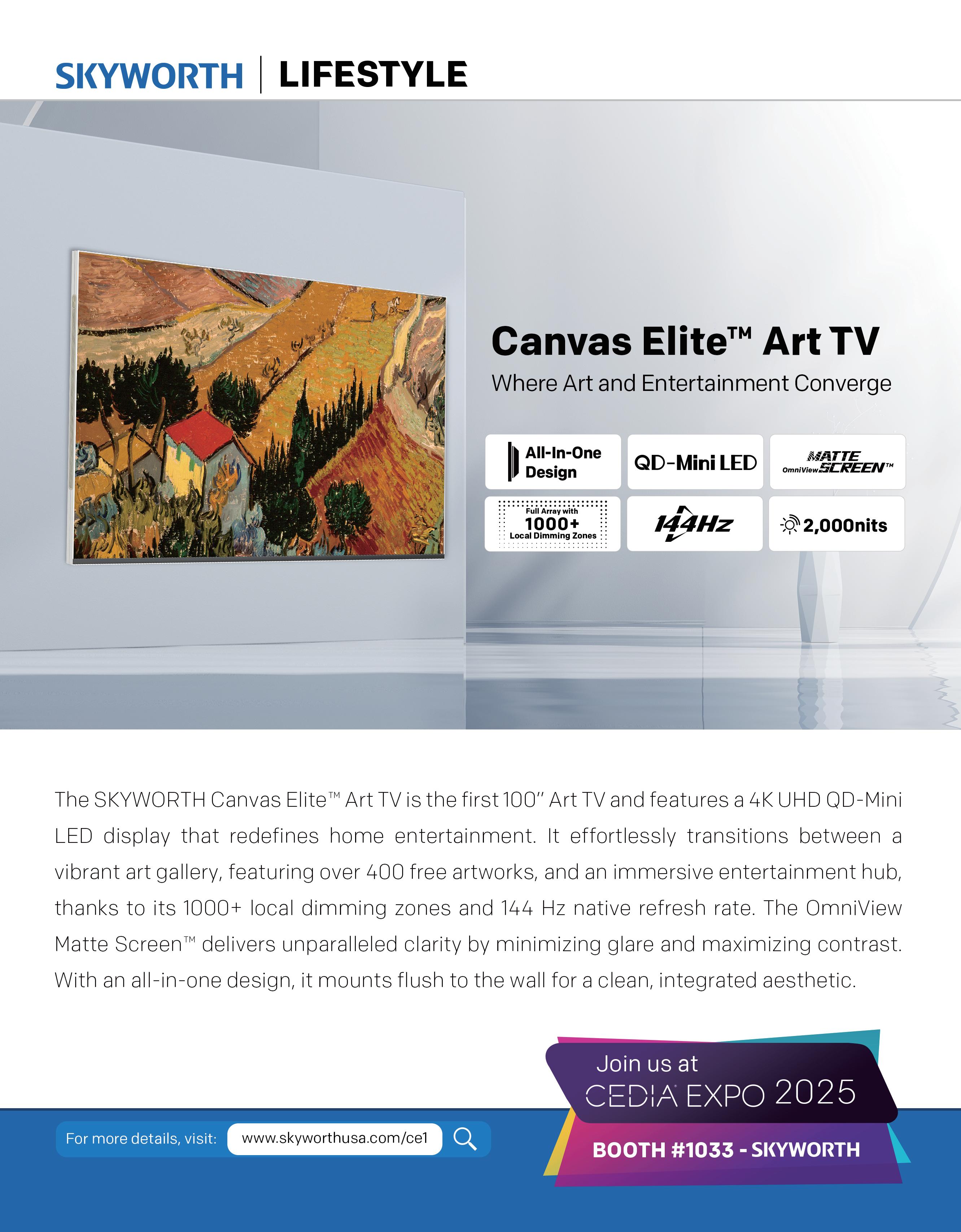


BY MATT BERNATH
I was talking with a successful integrator who’d just hit a major milestone. His business was humming along beautifully — consistent revenue, great team, and profitable projects. But what struck me wasn’t just his success; it was how relaxed he seemed.
“Five years ago, I was working 70-hour weeks and constantly stressed,” he told me. “Now I work maybe 30 hours, take real vacations, and the business actually runs better than when I was trying to control everything.”
He’d figured out something that most business owners never discover: How to build a business that works for you instead of against you.
During a recent episode of The Flywheel Effect podcast, my co-host, Brent, and I dove deep into this exact topic — what separates businesses that create freedom for their owners from those that keep them trapped. What we found was a surprisingly simple framework that any business owner can implement.
We’ve identified three core pillars that every sustainable, scalable business needs. Think of it like designing a home system — you need reliable power, smart controls, and seamless integration. Miss one pillar, and the whole thing becomes unreliable.
Let’s start with something exciting — predictable revenue growth. Not the feast-or-famine cycle that exhausts so many business owners, but steady, reliable income that lets you plan and invest with confidence.
A Reliable Lead Engine: Your next project shouldn’t depend on luck or waiting for the phone to ring. The integrators who’ve mastered this have multiple lead sources working simultaneously — referral systems that consistently generate warm leads, strategic partnerships with builders and designers, or targeted marketing that attracts new people into their circle.
An Expert Sales System: This isn’t about being pushy or manipulative. It’s about guiding the right clients to confident decisions. The best sales systems create a smooth buying atmosphere rather than selling, helping clients understand their options and providing clear next steps.
A Consistent Closing Framework: Here’s where many integrators leave money on the table — they don’t follow up consistently. Most home automation decisions involve multiple stakeholders, significant investment, and careful timing. A prospect who says “not now” isn’t necessarily saying “not ever.”
Building a great team is one of the most rewarding aspects of business ownership. When you get this right, you’re not just creating jobs; you’re building something that makes everyone’s life better.
A Winning Hiring Formula: This is all about creating systematic approaches to attracting, identifying, and onboarding the right people. It’s not about being naturally gifted at hiring — it’s about following

proven processes. You don’t need to find unicorns; you need people who are a great fit for specific roles.
Strategic Growth Planning: As your business grows, you need different people in different roles. The most successful business owners I work with have implemented strategic growth models, so they know who to hire and when. This kind of planning ahead makes growth smooth instead of chaotic.
Leadership Development: Your business will never outgrow your leadership capacity. But here’s the exciting part: Leadership skills can be developed with the right guidance and accountability. Every time you level up as a leader, you unlock new potential in your business.
This is where the rubber meets the road — turning your expertise into consistent, profitable operations that don’t require your constant oversight.
Financial Confidence: Successful business owners make decisions from a place of financial strength, not financial guesswork. You should know your numbers, understand your margins, and be able to see at any point how much money in the bank is actually yours.
Eliminating Bottlenecks: The goal isn’t to make yourself unnecessary; it’s to make yourself available for the highest-value activities. When you’re not the bottleneck in every decision, you can focus on strategy, growth, and the parts of the business you enjoy.
Proven Processes: Documentation isn’t just for big corporations — it’s the foundation of scalable operations. When your processes are documented and systematized, quality becomes consistent, and training new people becomes straightforward.
This might all seem overwhelming, and here’s why: Most people overestimate what they can accomplish in one year and underestimate what they can accomplish in three or five years. Don’t try to fix everything at once, or even this year. Business improvement isn’t about dramatic overhauls; it’s about focused, consistent progress with the right framework to guide you.
Pick one specific area — maybe it’s implementing a systematic followup process, or documenting your project management workflow, or developing a reliable referral system. Focus on that one thing for 90 days and make it significantly better.
What’s exciting about this framework is how improvements in one pillar support the others. When you have sales certainty, you can invest in better people with confidence. When you have trusted team members, you can implement more sophisticated processes. When you have profitable production, you can invest more in sales and marketing.
It creates a flywheel effect — each improvement makes the next one easier and more impactful.
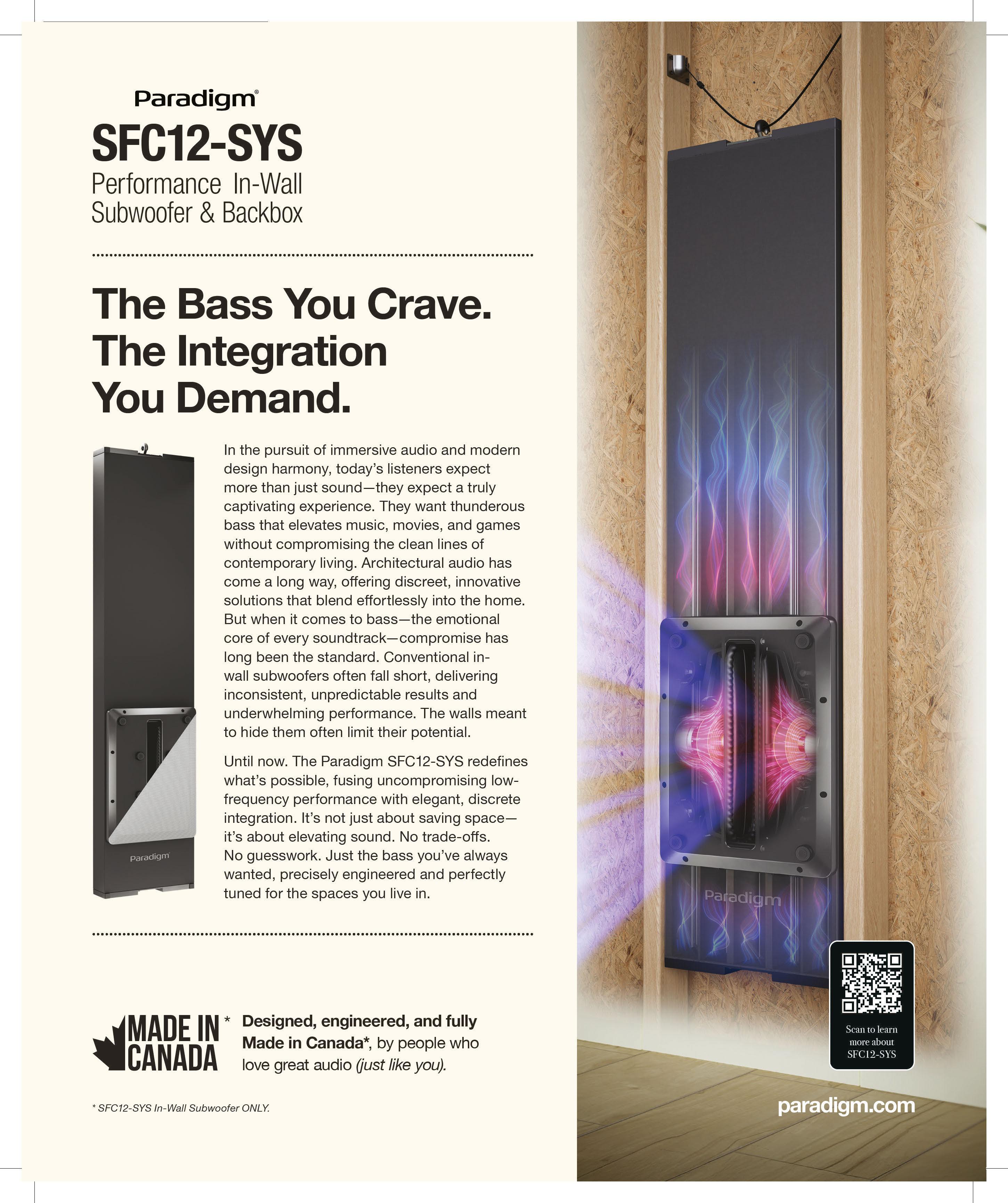
The smart home has become an established staple throughout the country — so what’s next?
BY GORDON VAN ZUIDEN
I’ve often been called a visionary because I started cyberManor, one of the first custom home technology integration companies in the United States, in 1999. Then, the focus was to use a broadband internet connection, a router, and a network switch to serve as the backbone of what is now commonly referred to as a smart home. That same year, Cisco filmed a smart home video at cyberManor, touting these technologies as the future of all new and existing homes.
Twenty-five years later, the smart home is now part of our everyday lexicon. It is no longer a futuristic concept, but now exists in every city and state in the country, with an average of 22 smart devices in every U.S. household [Source: Deloitte Insights]. Mission accomplished — so what’s next?
The smart home infrastructure has been built. We now need to build the service infrastructure to support all these smart homes reactively and proactively on an ongoing basis to ensure that every homeowner receives the maximum benefit and enjoyment from their evolving smart home systems.
As challenging as it was to build up a nation of smart homes, providing an ongoing, reliable, reactive, and proactive service of all these smart homes in a profitable manner will be even more challenging. A leading industry player recently sent out a survey to over 30,000 customers on how happy they were with their smart home systems. Customers provided an average Net Promoter Score (NPS) of only 40 out of a possible 100.
This low score means that the average owner of a smart home system is dissatisfied and is unlikely to recommend our channel’s products and services to others. To be fair, clients of some custom home integrators would give a higher NPS score. There is no greater challenge and opportunity in our channel than providing home technology support services for this frustrated client base. There is also no better way to increase the value of our businesses than by providing these services.
This also applies to the customers whose systems were installed by other custom integrators. Over the last two-plus decades of smart home technology, most clients have seen their primary custom integrator leave or go out of business. Fewer than 10% of the custom home technology integrators in the San Francisco Bay Area that cyberManor company competed against in 2000 are still in business today.
To date, how has the industry responded to these unhappy, stranded clients? Not very well. Taking over the home technology issues of a homeowner is not a strength of the custom installation channel. This is due to many, if not all, of the following reasons:
• Most custom home technology companies’ technical resources are typically at capacity just serving their existing customer base.
• Customers with service issues typically require a much faster response time than project-based customers, where some projects can take several years to complete, placing a strain on technical

resources that are primarily dedicated to project completions.
• Addressing the smart home issues of a new client can be extremely challenging; equipment is often outdated, wired and wireless networking infrastructures may be compromised, and software and firmware versions may be out of date or incompatible. It requires the most senior technicians with the greatest experience and broadest range of home technology troubleshooting skills to tackle these challenging issues.
• The customer is frustrated that they paid a lot of money for technology that no longer works well. The senior technician on these troubleshooting calls must also possess great interpersonal skills to help diffuse these tense initial service visits.
Those home technology companies that excel at providing reactive and proactive services to these dissatisfied customers will be the ones that will prosper and be most valuable over the next several decades. The following is a typical meeting scenario that serves to prove this point.
A customer who praises their custom integrator for their outstanding service will be the same customer who might someday be sitting in a meeting with their custom builder, asking to build their new dream home. That builder, or architect, or interior designer, will most likely tell the client that ABC is the best custom integrator in their area and they should be chosen for the new home’s technology systems. The client responds back with, “No, I already have an integrator that I trust implicitly who takes care of my ongoing needs, and I want to use them for my new home project.” The conversation as to who will be the new home’s technology integrator is done.
Throughout my home technology integrator career, I have witnessed this conversational exchange multiple times, and there is no better way to influence a new builder, architect, or interior designer to use your custom integration company on an ongoing basis than to prove to them that your project skills on this first job are as great as your service skills. Conversely, a relationship with a trade partner is highly dependent on the ongoing relationship of the custom integrator principal(s) and trade partner principal(s). If anything disrupts that relationship, it will have a significant adverse effect on the financial health and value of the custom integration company. A strong, ongoing home technology service relationship between a custom technology integrator and a homeowner lasts a lifetime.
As a custom home technology integrator, your success is directly related to the quality and performance of your team and how you prioritize these scarce resources. Nothing will enhance the success and long-term value of your business more than prioritizing the provisioning of outstanding reactive and proactive home technology services over the long term.
The smart home is still in its infancy, and it will need outstanding professional, long-term, recurring service care for decades to come.
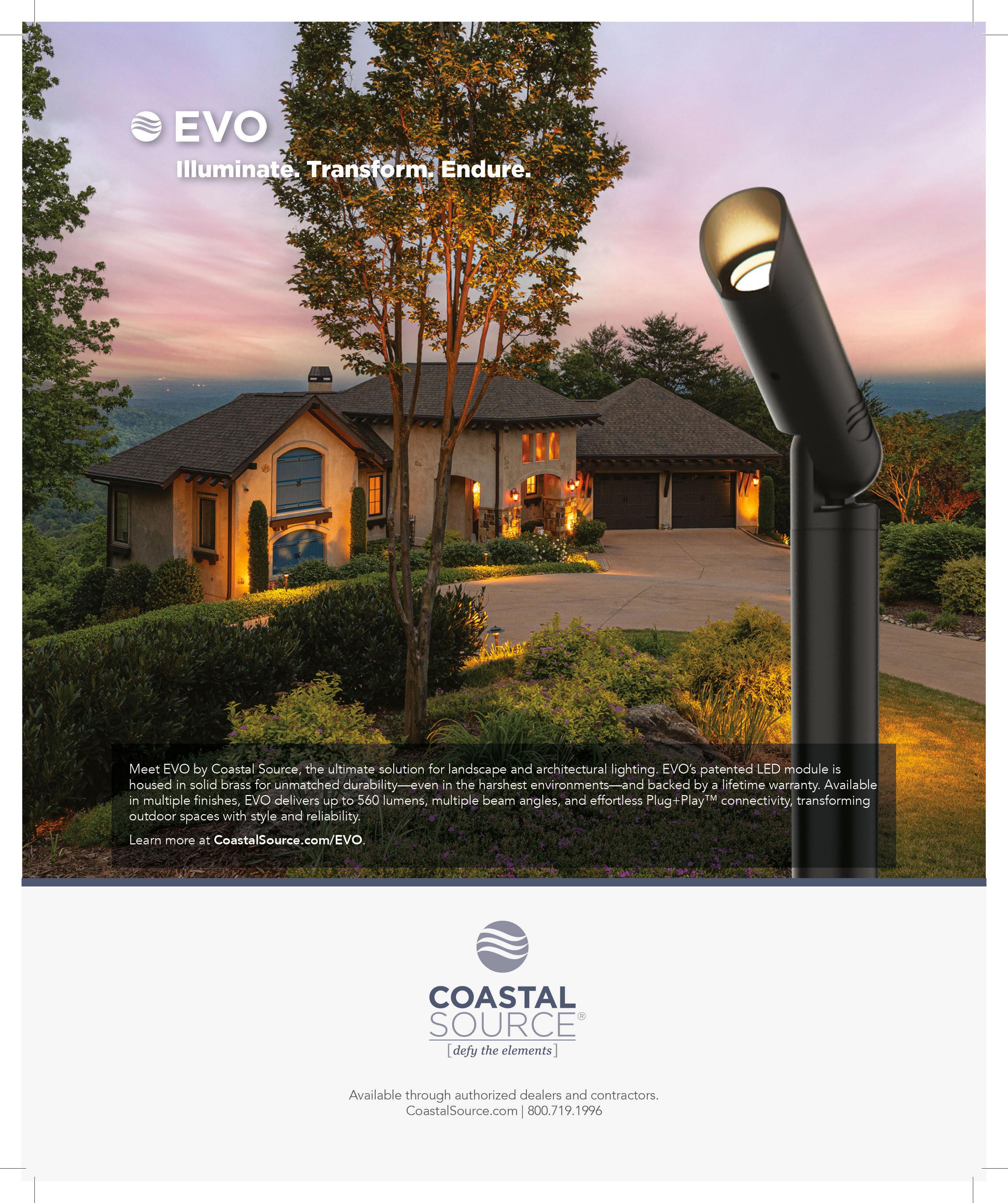
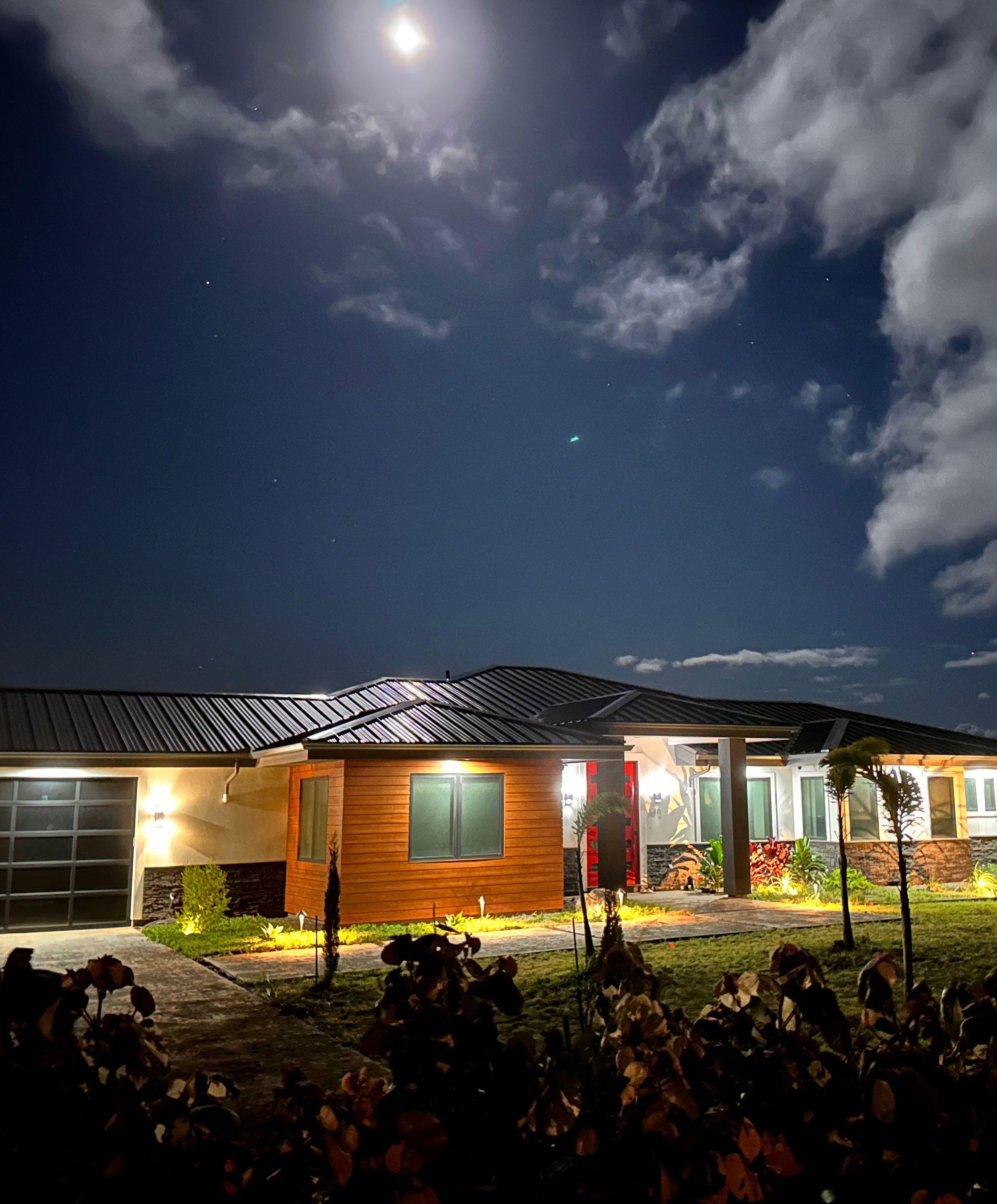
Certified Sounds helps to create a smart compound on Maui that provides refuge and support in the wake of the August 2023 wildfires.
BY ANTHONY SAVONA
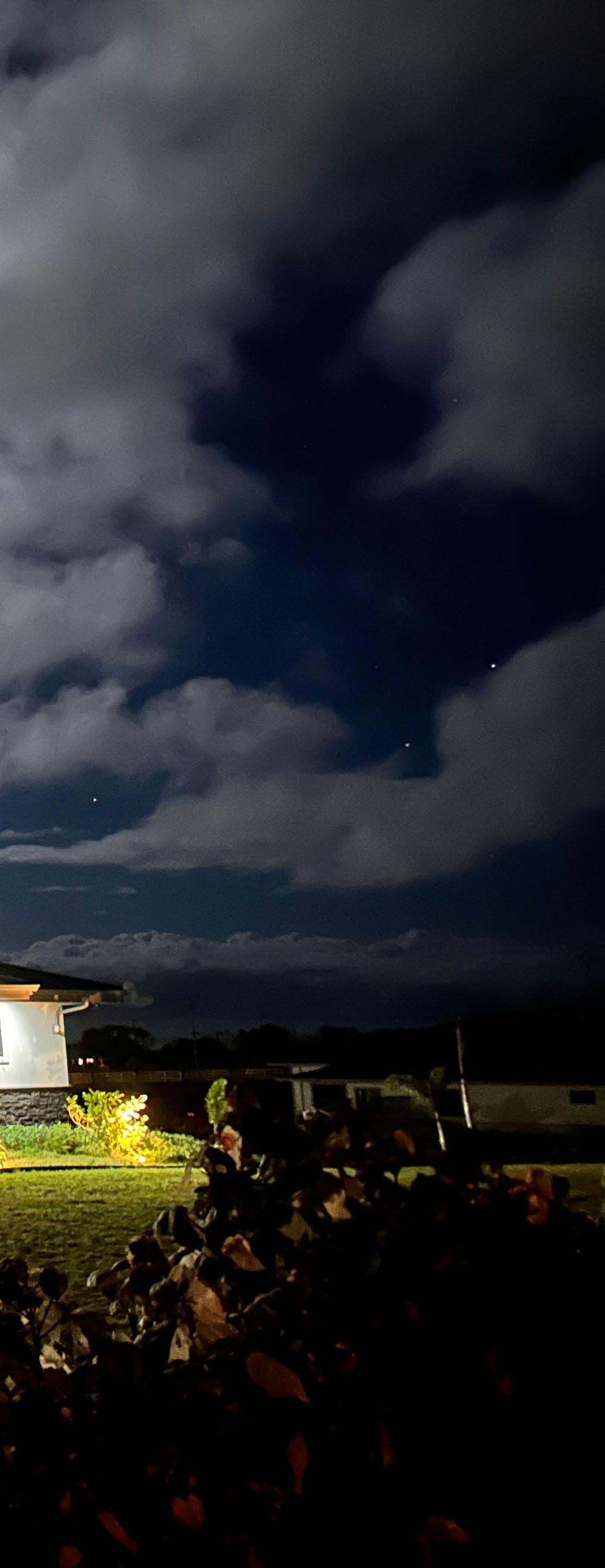

In August 2020, Tianna Krause and her husband, Keoni, owners of King’s Painting LLC, bought a six-acre property in Maui, Hawaii, that they intended to use to build their dream home. While plans got underway, they first built a few smaller structures, including a 976-square-foot cottage for them to live in during construction, a barn for Keoni’s many projects, including automobile restoration, a she-shed with one bedroom and bathroom for when their children visited, and a large garage for the family’s collection of cars.
Construction on the main home was set to begin when the Maui wildfires struck on August 8, 2023.
Fortunately, while there was also a fire near the Maui Tropical Plantation — just a few streets away — that posed a potential threat, it did not reach the property. Had it been necessary, Keoni was prepared to dig a firebreak using their heavy equipment. Once the immediate danger passed, the Krause’s quickly mobilized, opening their home to those who had lost everything and assisting with the transport of supplies into Lahaina, which had been devastated.
Their existing spaces quickly filled with friends and relatives who had lost their homes, taking shelter in the garage and she-shed. A close family friend, who had already been living on the property in his RV, generously offered it to one of the Krause’s best friend’s familiy to sleep in, while he spent the night of August 8 in his car.
The Krause property naturally became a gathering point for those in need. “The fires made us want to build our home faster because we weren't sure what was going to happen,” says Tianna. So, they got down to work, bringing on Derek Pace and the team at Certified Sounds to handle the technology from the very start.
Most of Pace’s business was in autosound, but a few years ago he rediscovered his love of home audio and began working to turn his company in that direction. “Audio is my passion,” he says. “We do smart homes and shades and everything for the home, but 2-channel audio is my forté. So, in 2018, I bought a new building and started constructing the showroom to show what we can do.
“I started getting momentum, and everything was going well. At the beginning of August 2023, I thought, ‘Hey — it's finally going to be a profitable year.’ Then the wildfires hit, and it was a setback because the whole island just stopped. It affected everybody. So, it's been challenging.”
Pace put his bid out for the new 8000-square-foot Krause home, knowing that, if he landed it, it would be the biggest home project Certified Sound had ever done.
“Keoni has known Derek for around 18 years,” says Tianna. “Derek did the sound system in my car, my son’s car, and my husband’s car. We knew he was looking to change the direction of his business, and we liked his
view of the house. This was going to be our forever home, and Keoni wanted it to be modern and up to date. Derek made sure that happened.”
With Keoni as the contractor and Tianna as the interior designer, Pace was in with the design and build teams from the very start, which helped create the modern home the Krauses were looking for.
That early access paid off quickly, as for the home’s many windows, Pace was able to install PowerShades motorized shades in pockets so that, when raised, they are completely invisible. “They're hidden so you don't even know that they're there until they start coming down,” says Tianna. “It's funny because our grown kids have seen a lot — we've traveled quite a bit with them — but when we're making the house dark by lowering all the blinds, they just think that it's the coolest thing!”
Whole-home audio was a priority for the homeowners, and Pace made sure the system could do all that they wanted it to do. “The house was really well thought out for audio,” he says. “It doesn’t overlap — you can still watch a movie in the living room and listen to music in the kitchen, even though it's an open space.”
“I wanted to be sure that we can play the music we want wherever we are in the house,” says Tianna. “My son can play rap downstairs, and I can listen to my music in the kitchen. Derek knew that was important to me.”
The installation features seven zones of distributed audio powered by the URC HDA-8100 and pumped through Bowers & Wilkins 700 Series in-ceiling speakers. The system processing includes an integration with Autonomics and the Krause’s preferred streaming source to provide easy access to music anywhere in the home.
A URC system controls the house, with a Lutron RA-3 system providing lighting control throughout.
“I had a few questions for URC tech support,” says Pace. “That's one of the best things about being in Hawaii — I send an email when they're closed, and the next morning I'll either have an answer in the portal or someone will be calling me. It's just awesome.”
With so many people visiting and staying on the premises, URC’s easyto-learn interfaces would seem to be the main selling point, but that wasn’t of much interest to Tianna. “Derek had put URC control inside my cottage, as well, so I already knew how to use the system,” she says. “It is easy to use, but I don't let anybody else touch it — I control it, and everything is pretty much set. If we are having a party, I can play music and I can put it in the outside patio, my great room, and the dining room, and I can change the music downstairs in the family room where we have our pool table. So, it just works. You can change the vibe for wherever you are in the house, which is amazing.”
On the main floor, there is a living room with a 98-inch Sony TV and the Bowers & Wilkins in-ceiling speakers, which can all be controlled along with the lighting and shades via wall-mounted, 9-inch URC TKP9600 touchpanels. Downstairs, which despite being where a traditional basement would be, still harbors the same amazing views as the main floor, and holds the family room and the home theater.
The family room has a pool table and two TVs — one on the far-left wall and one on the right, which also includes a karaoke setup. That space also features the Bowers & Wilkins in-ceiling speakers.
Off the side of the family room is the 7.2.4 home theater, which features a Sony 98-inch TV (identical to the one in the living room) and a Marantz Cinema 30 AV receiver that Pace says will be upgraded shortly to the latest Marantz AV20 and AMP20 separates “for more power and an enhanced
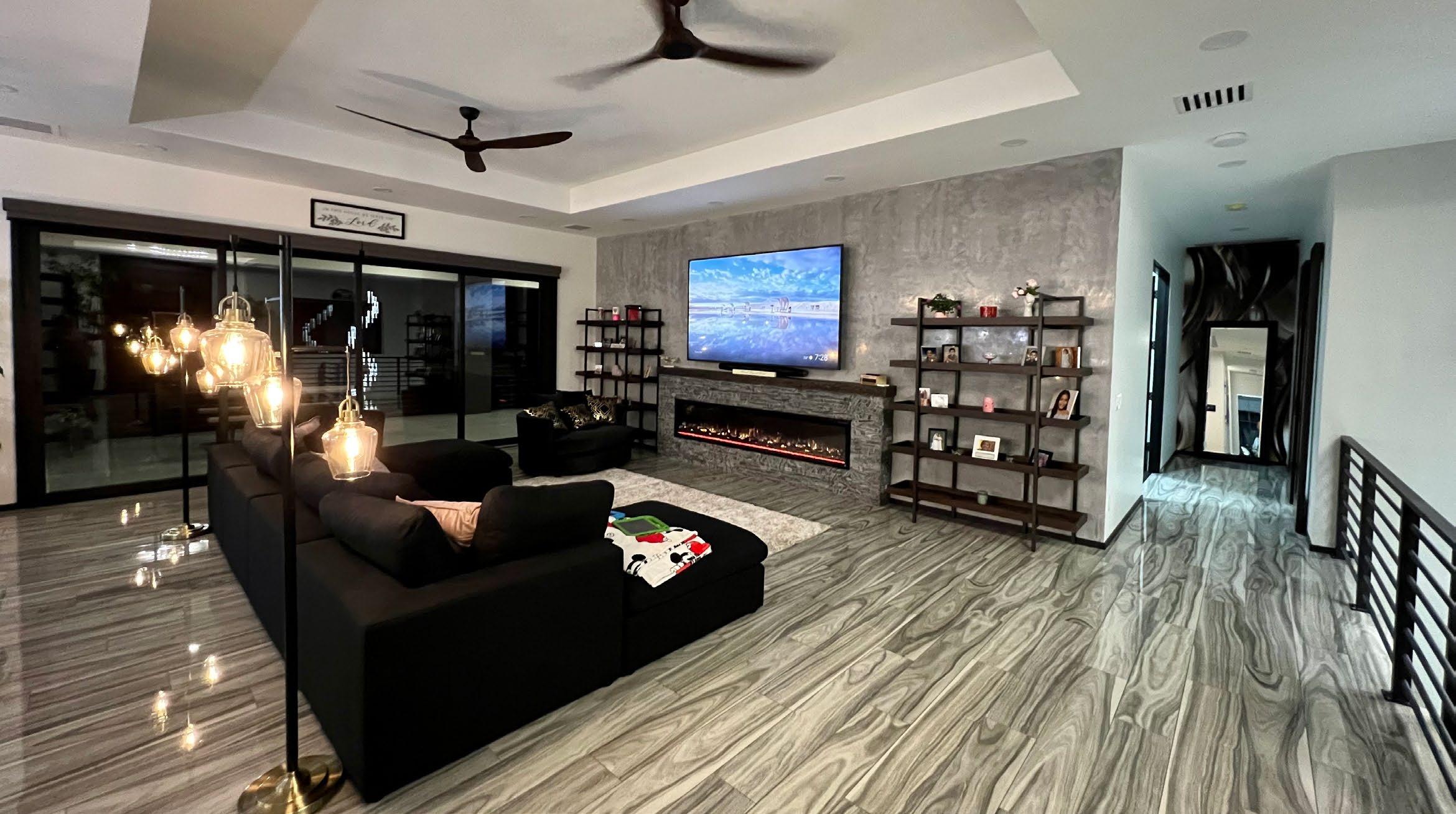
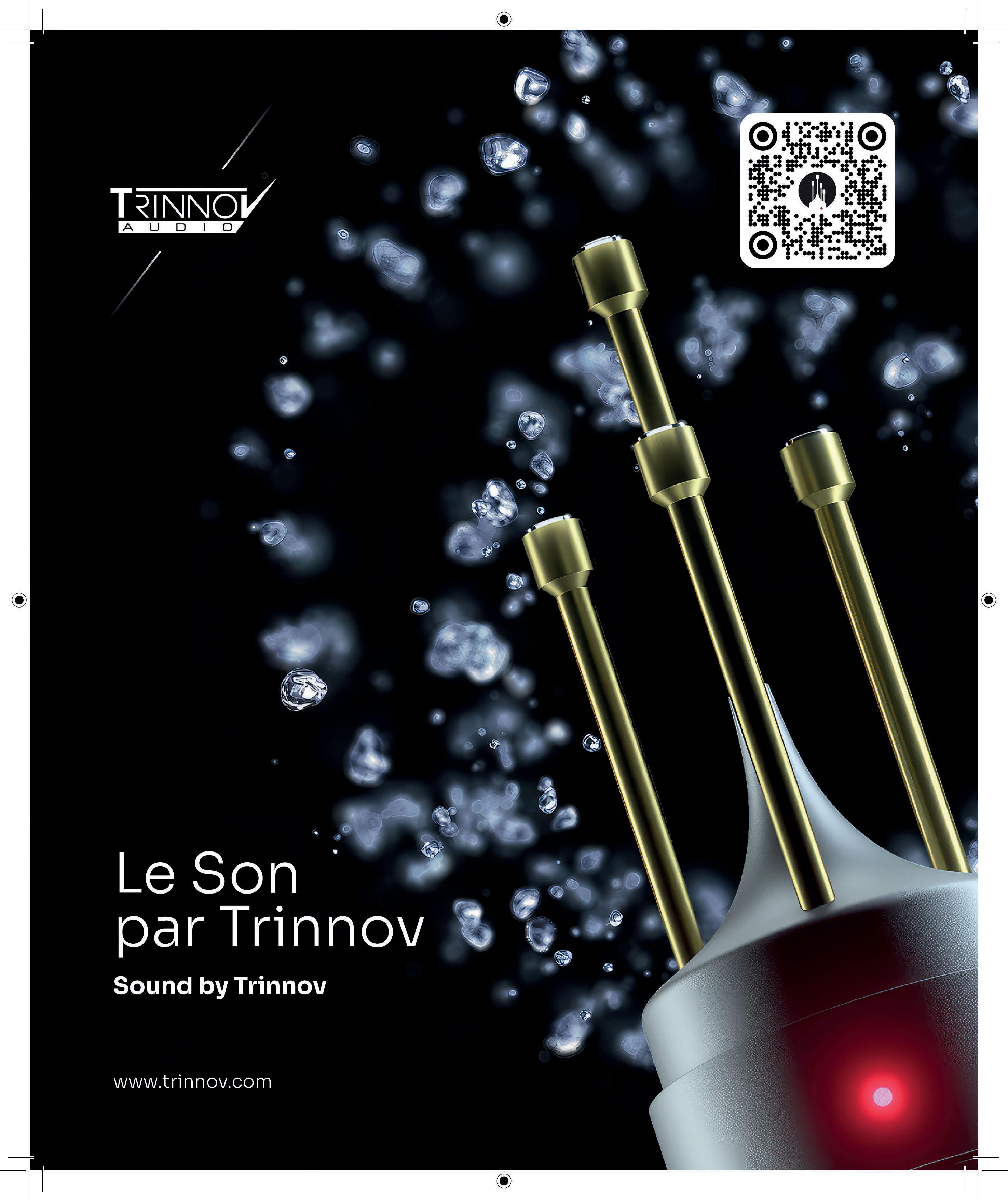
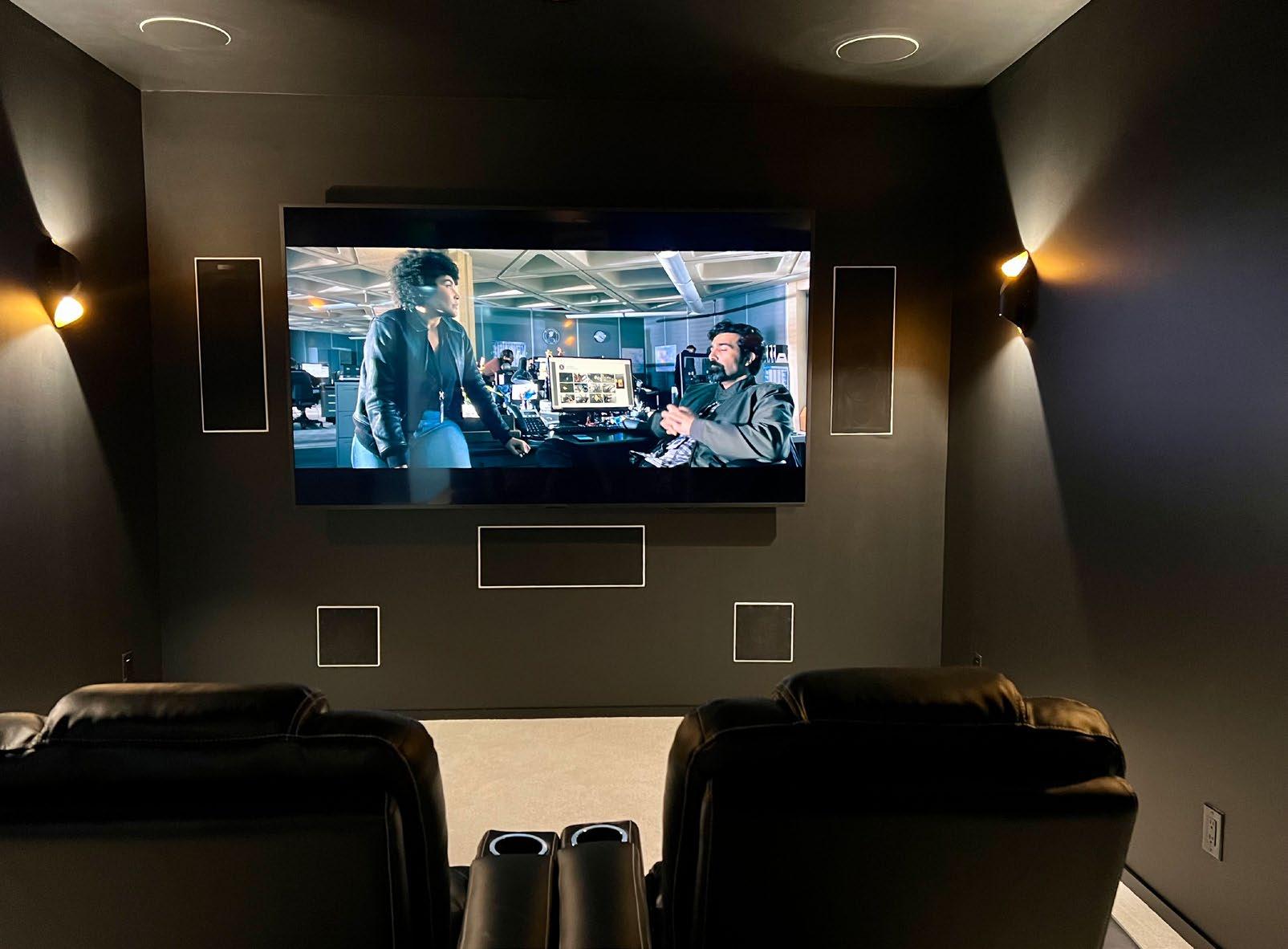

experience.” For speakers, the room uses Bowers & Wilkins 700 Series in-wall and in-ceiling models, with JL Audio SYS208 in-wall subwoofers. Playback is provided by Kaleidescape and a Sony UBP-X1100ES Bluray player.
Though the theater can pump out plenty of volume and bass, it doesn’t leave the room.
“The way they built it, there's no way for the sound to travel,” says Pace. “It's a separate, closed room, and he used special flooring that keeps the sound upstairs from bleeding down and downstairs from bleeding up.
Keoni went over the top, so you don't hear anything between the top and bottom floors. We also did back boxes for all the speakers, so they don't vibrate the ceiling.”
With the TV upstairs and the three downstairs in the family room, there are enough entertainment options for visitors that the home theater can be prioritized as an oasis for the core family. “It’s our prized possession,” says Tianna.
The Krauses moved into the main house about a year ago, with family members immediately moving into their cottage. Each of the structures on the property still hosts family and friends, some of whom have decided to stay there permanently.
Next steps for the home include the addition of a pool, which Pace has already pre-wired for. But until then, there is still plenty of home for them to enjoy.
To help with the rebuilding of Lahaina, Keoni and his business partner, Rey Cotto, have started a contracting business to give their neighbors a local choice and to avoid those contractors looking to take advantage of the situation. Tianna runs the family’s painting business, now armed with the knowledge of building several structures from the ground up over a very short period of time. And the couple continues to bring everyone together for dinners and parties — including Pace.
“They truly enjoy hosting and frequently have people over,” says Pace. “They love giving back and creating a space where others can unwind. They’re enjoying the home — it’s exactly what they envisioned, and they’re eager to share it. It’s really something special.”
“If we didn't acquire the property, I don't know what we would have done,” says Tianna. “We're super-blessed to have what we have.”

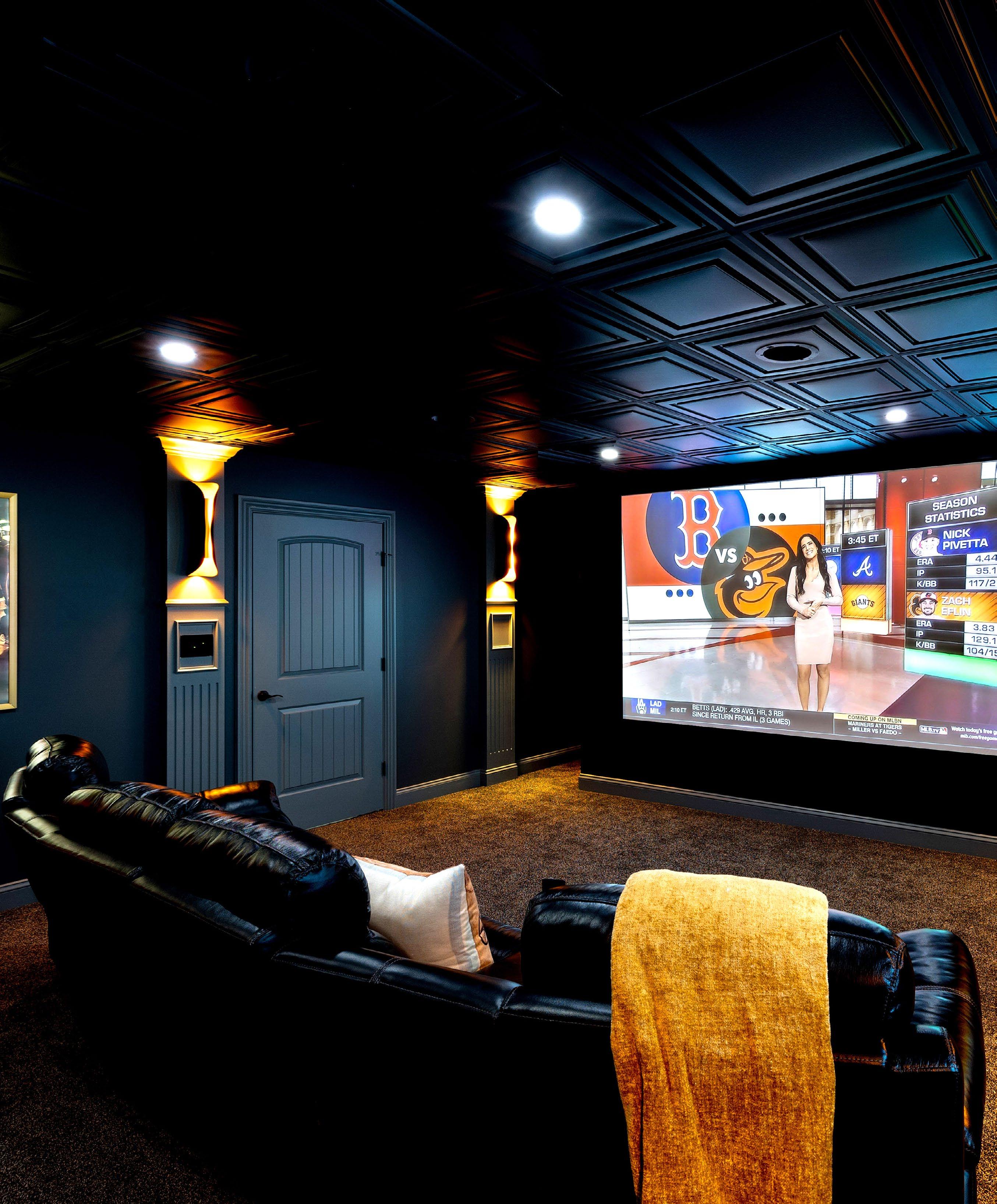
Cobb Home Innovations creates a private cinema that doubles as a presentation space for the owners and their employees.
BY ANTHONY SAVONA
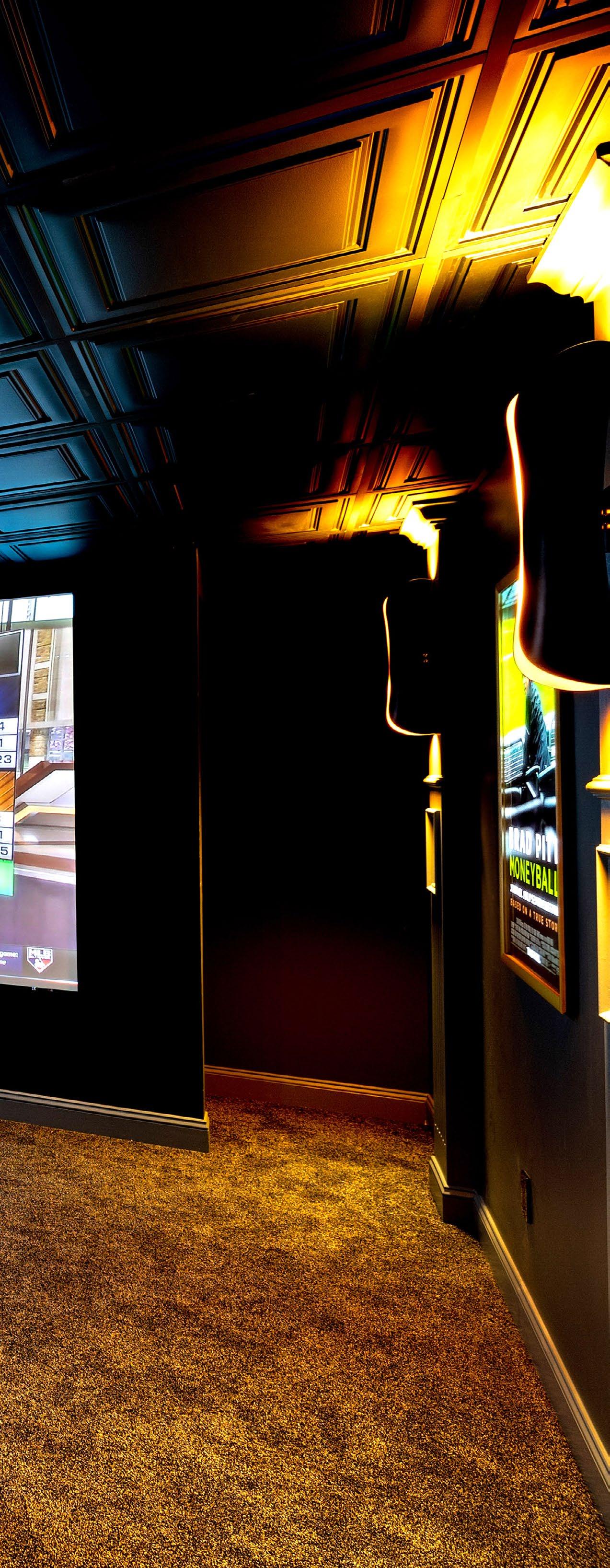
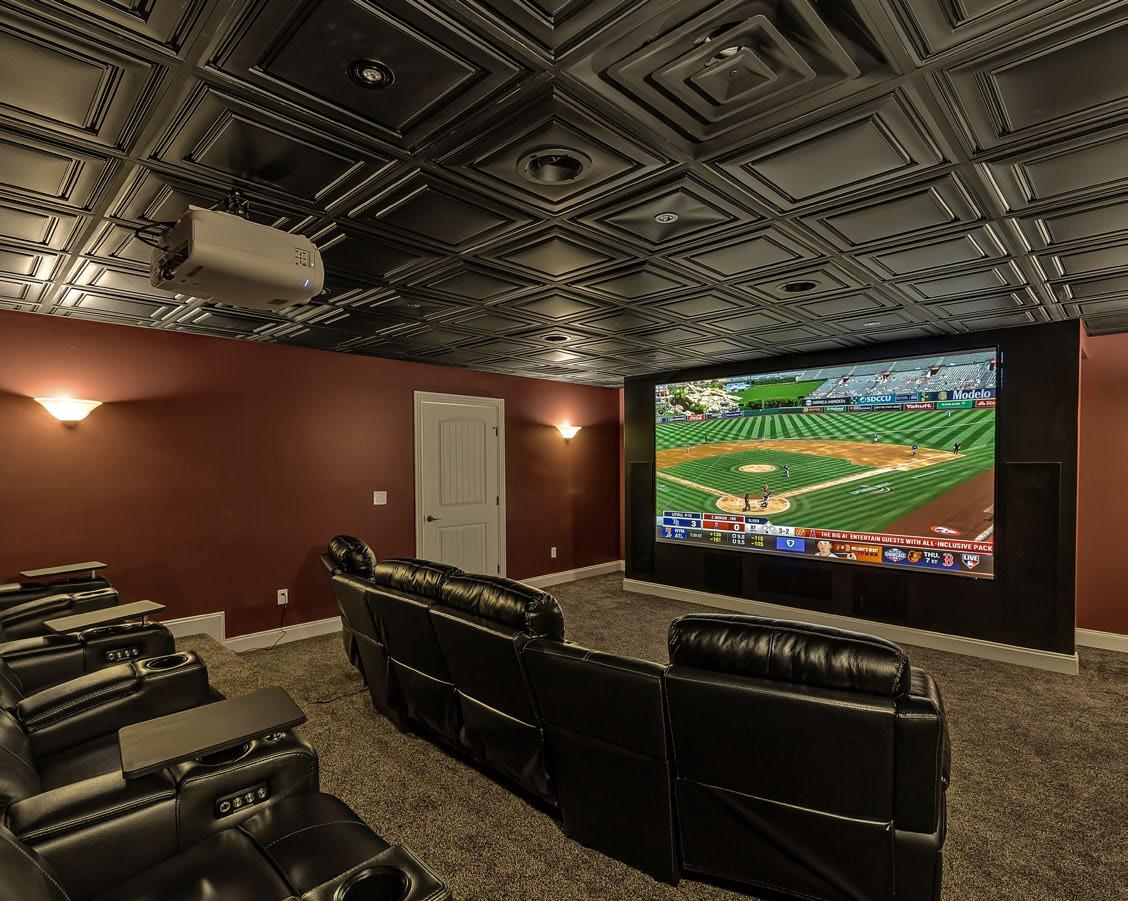
Creating a multi-purpose room is a pretty standard request in this industry, but when Woodbury, Tennessee’s Cobb Home Innovations was hired to update a home’s technology and add a private theater, it was not quite what they expected.
“This was a new client,” says Hugh Cobb, owner Cobb Home Innovations. “They just purchased that house, and they called us in because they wanted to add a home theater, but they were also interested in adding smart home technology. For the latter, we installed iPads in walls, added MantleMount motorized TV mounts, and introduced Lutron lighting control and shading control into the space. We also did their security system.”
The client had an area in the basement designated for the home theater, along with two demands: it had to accommodate the homeowner’s work presentations, and it could not have a dedicated rack room.
The space was a good-size room — about 30 feet by 30 feet, with a high ceiling. The front and one side wall were concrete, the other two being drywall, so there were challenges to overcome.
“We did a drop ceiling, and we built a false wall for the screen,” says Cobb. “It turned out to be a two-stage job. We set the room up so that it could serve as their personal home theater and also as a place for their employees to meet to do presentations on the big screen. We had to get the internet straightened up, too, and give them a good mesh network.”
Cobb set that space up first and continued to work in the rest of the house, but something about the home theater was not sitting right with him.
“About a month in, when I started looking back at the photos of the theater — even though it looked good — it was very sterile. It looked good for a corporate meeting space, but not good for a home theater,” he says. “I talked to the client and told him that he needed to bump this room up cosmetically to make it pop as a home theater. He agreed, so, for the second stage, we went back and gave that room a face lift.
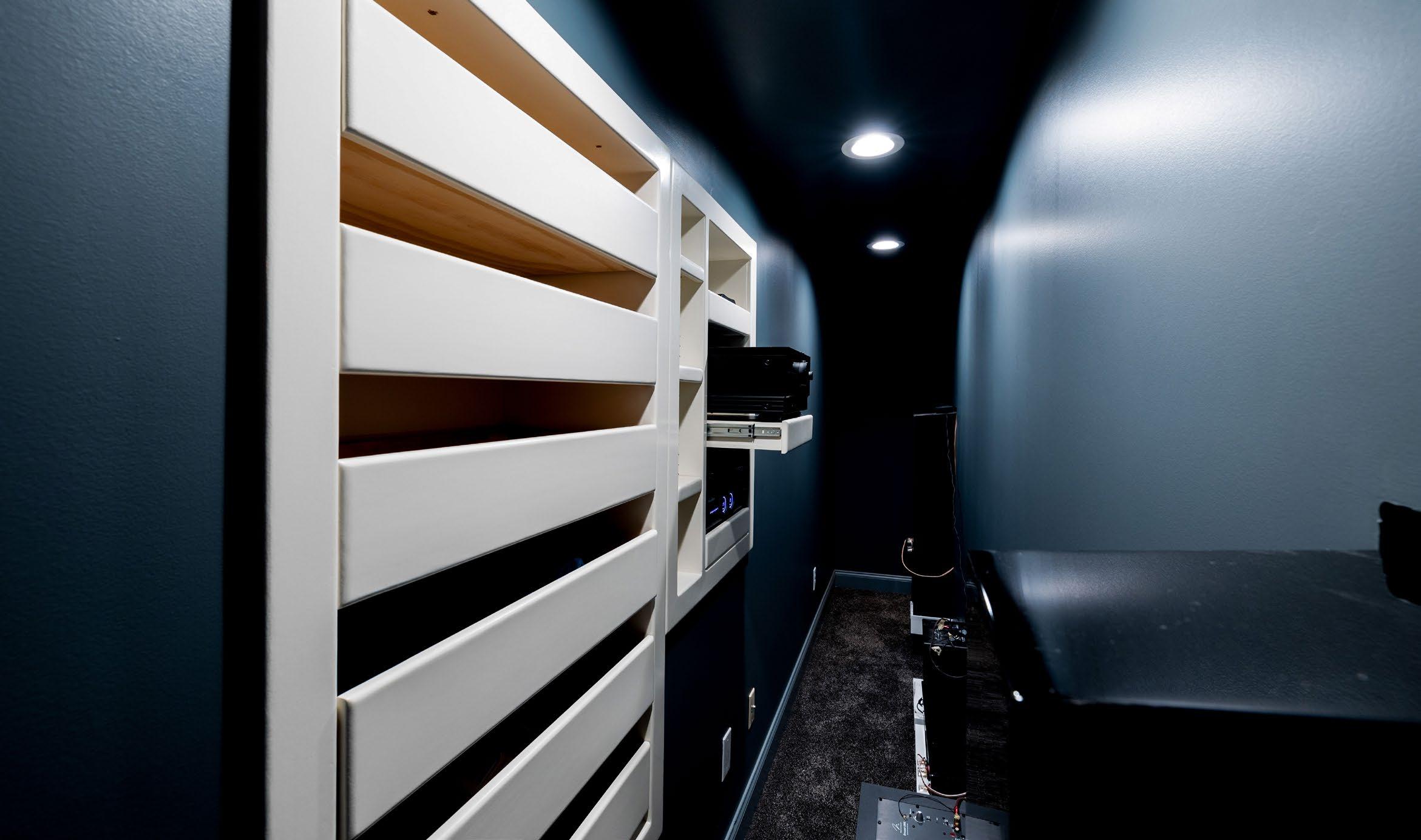
“We changed the color palette of the room and the carpet. We have a fabrication shop, so we built custom columns with unique sconces that were found by our interior designer, Joyce Cobb, for the room.”
The Lutron lighting in the room helped to complete the look. “Originally, he was at a 6500K for presentations, which is very white and very commercial,” explains Cobb. “Then we dropped it to around 3500K, which made it look warm and inviting. He can adjust between the two settings depending on how the room is being used.”
Video for the 10-seat space is provided through an Epson LS11000 4K Pro UHD laser projector with a Sony UBP-X800M2 4K Ultra HD Blu-ray player and a Roku Ultra 4K streaming media player as sources.
The false wall that holds the Screen Innovation Zero Edge projection screen also hides Cobb’s solution for not having a rack room — a “rack hallway,” as it were. Behind the front wall is a three-foot-wide path that has the front subs placed against the screen wall and the back wall features the pull-out shelving that holds all the gear for the theater.
“We had custom cabinetry built for behind the screen so you can walk in from the left or right, and you’ve got access to the gear,” says Cobb. “We’ve got the cabinets on rollers, so they roll out to access the equipment and then roll back in when done. It is so easy to work on. I can go in there and unplug and switch something out in a matter of minutes with this job.”
Opposite the cabinets are two Martin Logan floorstanding subwoofers that are on platforms that come up just about to the baseboard molding for a clean look that still provides ample bass. Built into the wall on the other side are two MartinLogan Motion XT F100 tower speakers on either side of the screen and a Motion XT C100 center speaker below it.


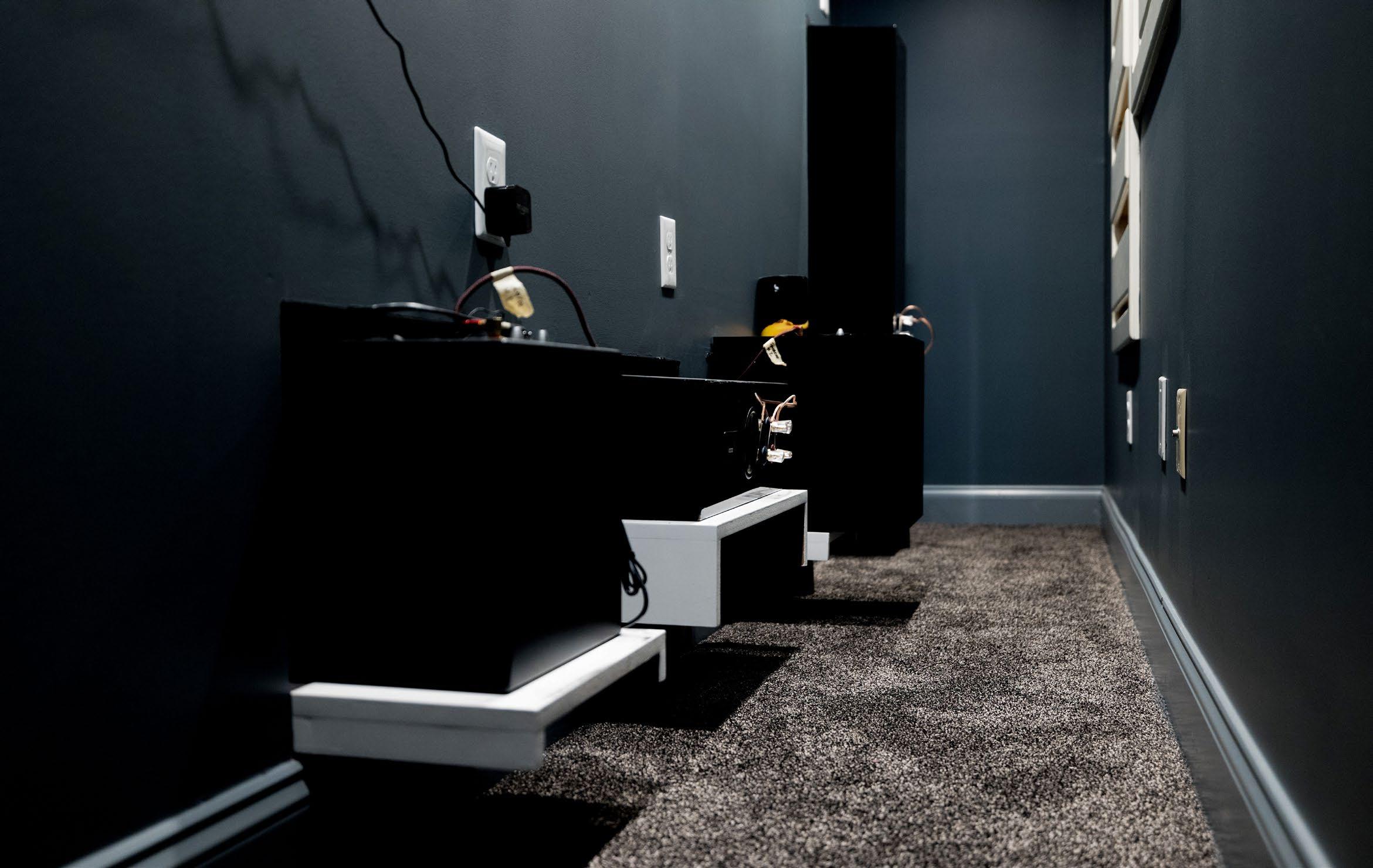
“About a month in, when I started looking back at the photos of the theater — even though it looked good — it was very sterile. It looked good for a corporate meeting space, but not good for a home theater.” —Hugh Cobb
Surround sound for the 5.2.4 Dolby Atmos room is provided by MartinLogan Motion XT Series in-ceiling speakers, as the client did not want speakers on the wall. “There are two rear channels on the back wall, but everything else is in-ceiling at the client’s request,” says Cobb. “It’s a little different, but it still provides an incredible sound.”
A Yamaha RX-A8 11.2-channel AV receiver is the audio brain behind the system. The home theater uses RTI for control and automation, though the rest of the house uses Apple Home.
In Cobb’s experience, jobs such as this one tend to grow from the initial consultation because the clients don’t understand the full capabilities of what the home can do until they get deeper into it.
“When we start a project, it is not uncommon for us to you know take left turns from where we originally wanted to end up once we start doing all this cool stuff,” says Cobb. “Ninety percent of the time they do a lot more than

that. They just fall in love with what we’re doing.”
Helping them visualize is the Cobb Home Innovations appointment-only showroom, which includes two Dolby Atmos theaters. “It takes about two and a half hours to go through our experience center,” says Cobb. “So, when a client comes here, we can walk them through the whole venue and go through smart home technology and audio/video. When they do that, they can see it in a whole different light, and they get it.”
Of course, inspiration goes both ways.
“This home theater led to me redoing my office space,” Cobb adds. “I am going to put those sconces in my office!” For more information, visit cobbhomeinnovations.com.
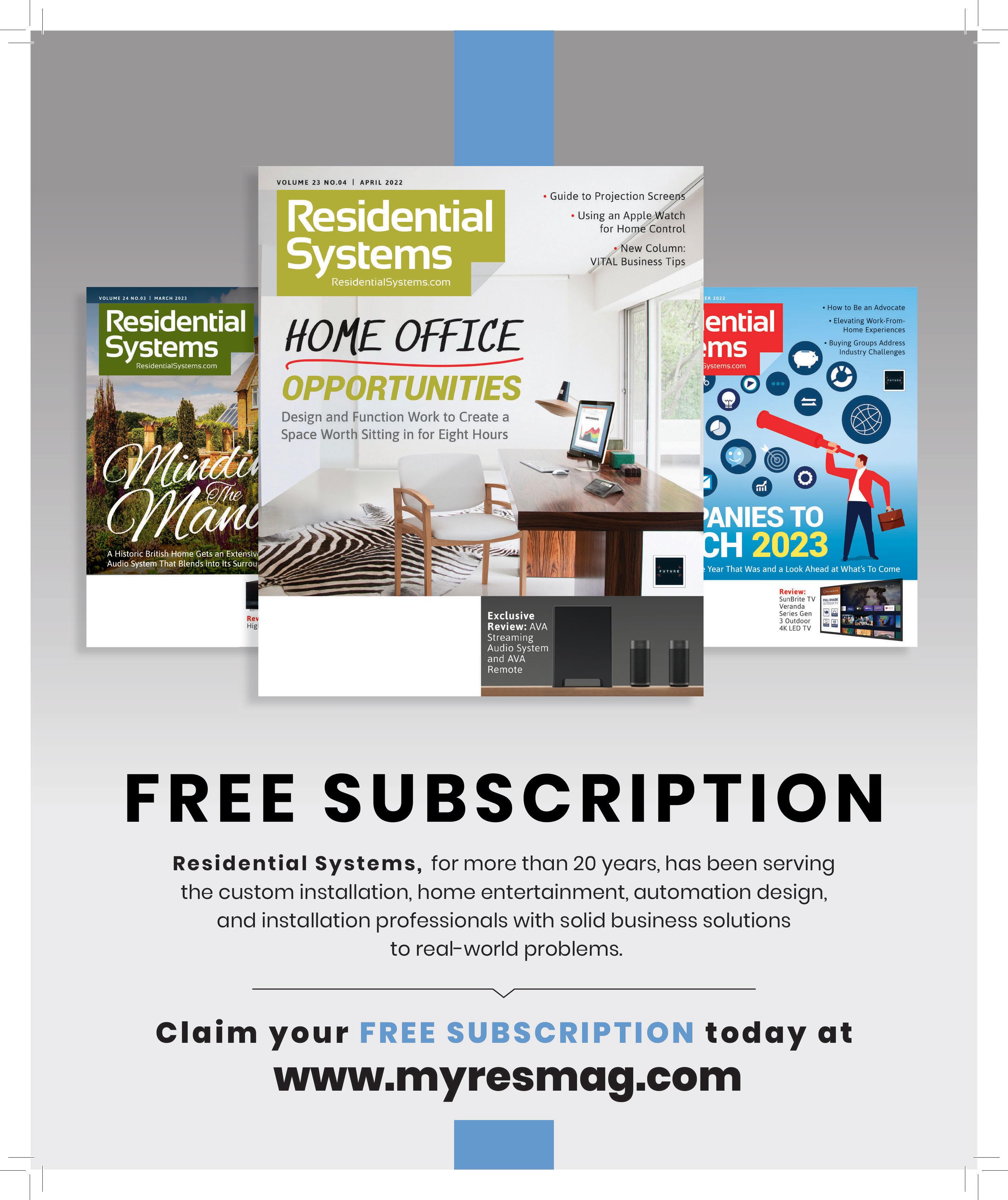
The trailers are mixed in reference-grade environments, including Trinnov-calibrated rooms and studios like MSM in Berlin.
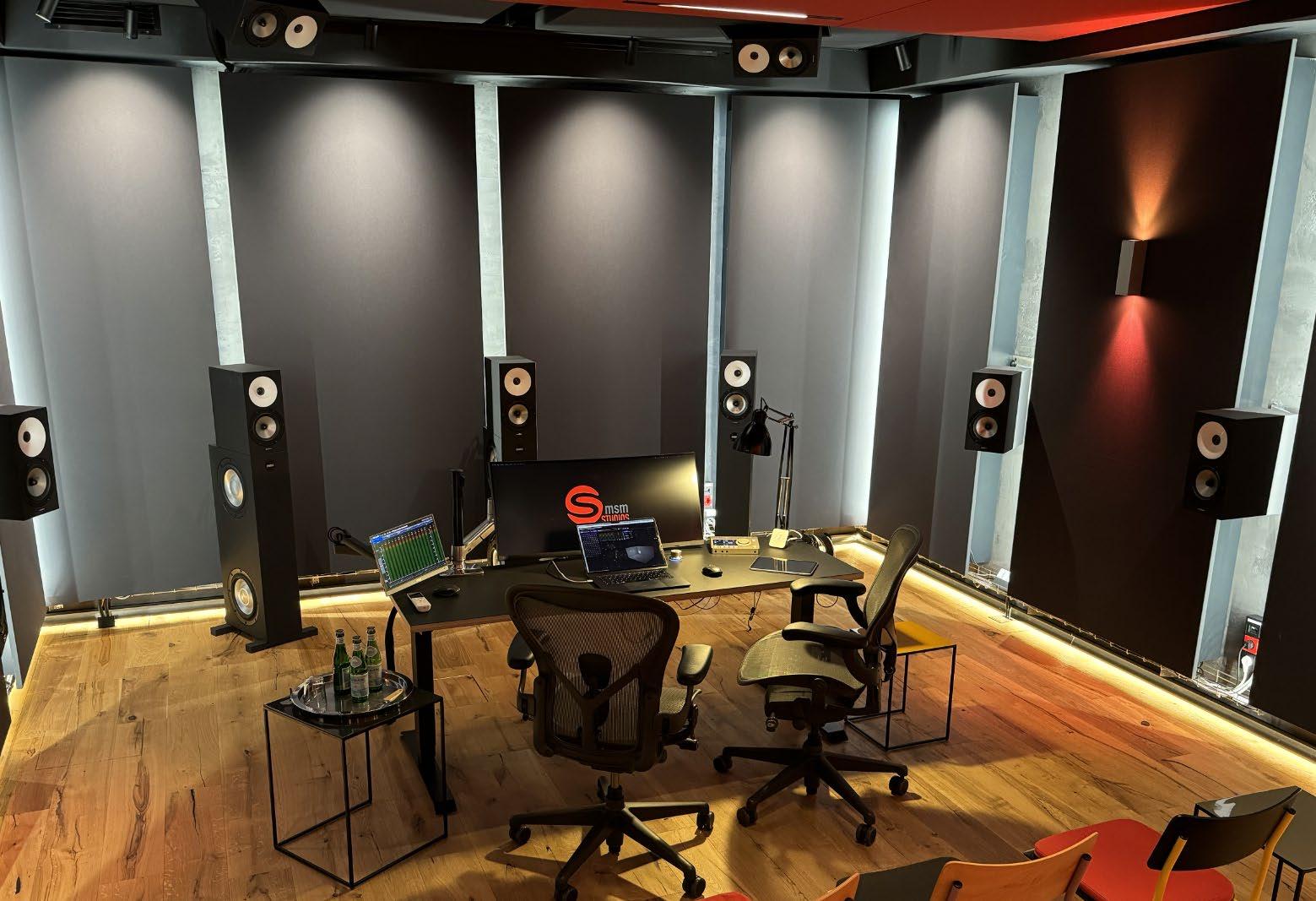
Why Trinnov decided to create original trailers that offer a perfect immersive experience.
It is no secret that dealers, integrators, and installers are on a never-ending quest to find content that effectively demonstrates the full potential and power of an immersive home theater system.
Every year around this time, the industry has an entertaining and time-honored tradition that lists the “best demo scenes” that are curated from the recently released movies or streaming titles. While many of these scenes are visually spectacular and often packed with dynamic sound, they’re not purpose-built to fully exercise advanced speaker layouts, showcase nuanced sound design, or make proper use of all the channels and formats now available.
Trinnov Audio recognized a gap and decided to take matters into its own hands. The company has taken a bold, creative step by producing its own immersive trailers. These cinematic shorts aren’t marketing reels or product promos; they’re meticulously crafted audiovisual experiences designed to challenge systems, thrill listeners, and spark conversation.
Here, Benoit Muñoz, Trinnov’s marketing manager and the visionary behind the project, provides the full story behind this unique initiative.
Why did Trinnov decide to create its own trailers?
When I joined Trinnov almost 10 years ago, immersive sound was just entering the home theater space, but the majority of players had moved beyond what I refer to as the “golden age” of producing trailers. The content that existed was often tied to specific formats, and I felt that did not reflect Trinnov’s agnostic approach to audio. So, in 2020, while preparing for Integrated Systems Europe, I saw an opportunity to try something new. We were debuting our support for DTS:X Pro, and I wanted a piece of content that would show off the format in a creative, exciting way. With limited resources and a lot of support, the first trailer we produced, Experience, was short (about 30 seconds), but it helped prove the concept, and we knew it was the start of something special. That was the beginning of something much bigger.
Who are these trailers really intended for — dealers, integrators, or end users?
The honest answer is that they’re made for us first. That’s often the case in creative work; you build something that satisfies your own standards, and

if you love it, you hope that others will, too.
That said, we’ve always had the integrator and enthusiast communities in mind while producing these. We have aimed to create trailers that resonate with both groups because we know they are the people who key into every detail, who know — or in some cases want to know — just what their system is capable of.
We receive a lot of feedback from longtime industry partners, typically seasoned calibrators and integrators, but we’re always elated to hear about enthusiasts using these trailers at home to show off the full capabilities of the home theaters they have poured energy, investment, and passion into building.
Tell us about the creative process. How do these trailers come together? Each trailer begins with a spark: a visual idea, a technology we want to explore, or a partnership with an emerging artist. For example, Les Dieux started with stunning visual work by Lucio Arese, and we built an audio experience around it that pushes the limits of low-frequency reproduction. It’s now a favorite among calibrators who want to see how far their subs can go.
All our trailers are mixed in reference-grade environments, including Trinnov-calibrated rooms and studios like MSM in Munich and Berlin, where many industry-standard Atmos titles are mixed. That gives us a solid foundation, and from there, we push boundaries.
How have integrators and dealers responded to this content?
The feedback has been phenomenal. We often hear directly from those who’ve integrated our trailers into their showroom demos and seen powerful results. We understand that integrators and dealers are constantly seeking engaging, fresh content to showcase the transformative impact that immersive audio can have, and we’re happy to provide access to trailers we feel fit that bill. As a notable example, one partner of ours in Sweden told us several of their customers upgraded entire systems after experiencing a true Trinnov demo.
While we take great pleasure in testing these trailers among our core crew and most passionate collaborators, I can say that perhaps the most gratifying response has come in the form of uptake by our industry partners. It’s validating to see our trailers integrated into Kaleidescape players within the finest home theater showrooms in the world. That is a real compliment to our team and the philosophy behind the trailer project.
How do Trinnov’s trailers differ from traditional demo clips or Hollywood scenes?
Unlike studio content, which is often visually compelling but sometimes

sonically conservative, our trailers are purpose-built to highlight immersive sound design. We pay special attention to channels that are underutilized in most films — like wides and ceiling speakers — because we want to show off the full potential of an immersive system.
Our trailers are concise, standalone pieces that have been crafted to highlight audiovisual excellence, all without blockbuster budgets or star power, might I add. These are cinematic experiences designed from the ground up to elevate the home theater demo.
Do you see this concept evolving even further?
Absolutely. The reception so far has encouraged us to keep going. We’re always developing new ideas and exploring collaborations with artists and engineers alike. What started as a small experiment has grown to take on a life of its own. We’re excited to expand on this concept further, and we’ll always aim to push the boundaries of immersive audiovisual experiences.
How can enthusiasts get access to these trailers?
They’re all available at https://hub.trinnov.com/trailers, and most are offered in multiple formats: Atmos, Auro-3D, and DCP. Anyone with a properly configured system can use them to explore the limits of their setup.
We’ve seen them used by hobbyists, calibrators, YouTubers…you name it. It’s a resource we’re proud to share with the entire home theater community.
at some of the more recent entries into this growing

The lighting solutions product category for the custom installation market continues to grow at a quick pace, offering dealers more and more options for the situations they encounter. Here, we look at some of the more recent additions to this diverse ecosystem, including downlights, tape lights, dimmers, keypads, and many more.
Lutron’s first-ever downlight in the Lumaris family is engineered specifically for the luxury residential market. With new construction and retrofit options in various sizes and colors, the new Lumaris downlights make it easy to add tunable white lighting (1800K–4000K) to any project. Designed with homeowners, designers, and builders in mind, this new fixture extends Lumaris’ capabilities beyond tape lights, offering a refined yet accessible downlight solution. With accessible pricing and easy-towork with form factors, Lumaris downlights are a simple upgrade that elevates the lighting experience in high-use spaces — such as kitchens, bathrooms, and bedrooms — where downlights are most used.
DMF Lighting’s Artafex PhaseX is a tunable white lighting platform that delivers professional-grade performance over standard two-wire Romex. Designed for the technology integration channel, Artafex PhaseX simplifies the delivery of dynamic, human-centric lighting across any residential project, whether new build or retrofit. At the heart of the system is the PhaseX Gateway, which controls up to 64 fixtures and connects seamlessly to any DMX-enabled system, including native support for Crestron Home. The result: scalable, precision-tuned lighting with ultra-smooth 0.1% dimming and personalized scene control, all without the need for specialized low-voltage wiring.

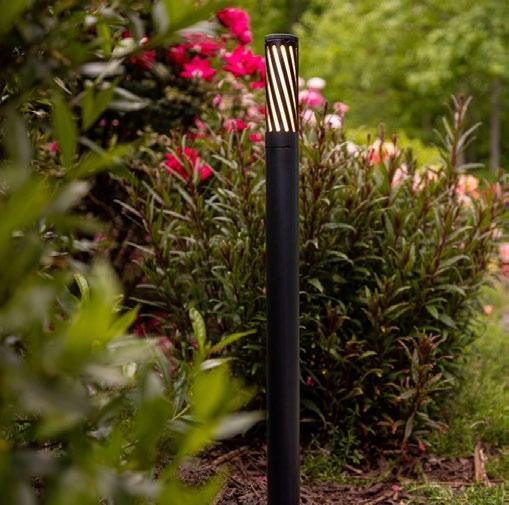
offers superior lumen output and a wider beam spread — perfect for highlighting pathways, architectural details, and outdoor living areas. Customization lies at the core of EVO. Designers can choose from an array of finishes, including Vintage Brass, Black, White, and Nickel, and personalize further with interchangeable shrouds, hats, and lenses to suit any style. Its Plug+Play technology enables quick, hassle-free installation, while integrated CREE LED modules deliver energy-efficient lighting.
The PoEWit RRM-1 is a 3-inch RGBWW Recessed LED powered by PoE. A single Cat6 cable sends power and data to the fixture via the UPD-1 Driver, as pictured. PoEWit also offers the UPD-1-PT Driver, which supports RRM-1 fixture and up to four other PoE devices, as well as the UPD-4 Driver, which supports up to four RRM-1 fixtures.
The RRM-1’s inner core is a 12W Tunable White COB with an appadjustable color temp of 2500K-6000K, a 36-degree beam angle, and a maximum lumen output of 1100 lm. The RRM-1’s RGB outer ring has an app-adjustable color wheel and a 55-degree beam angle. This IC-rated fixture is IP44 with a CRI > 90. The RRM-1 comes in Round, Square, or Trimless; White or Black; with a White, Black, Chrome, or Black Chrome baffle reflector.
The Leviton Decora Smart Wi-Fi 0-10V dimmer is the first Mattercompatible 0-10V smart dimmer. The new 120V/277V device makes it easy to add 0-10V dimming to smart platforms such as Apple Home, Amazon Alexa, Google Home, and Samsung SmartThings. The new dimmer adds smart control to 0-10V dimmable LED drivers and electronic fluorescent ballasts to set light levels in residential spaces such as garages, basements, A look
The EVO Lighting System from Coastal Source is a premium outdoor solution that merges modern elegance with high performance. Crafted from solid brass for maximum durability, EVO is built to thrive in the harshest environments while delivering powerful illumination with minimal glare. At half the size of traditional MR16 fixtures, it

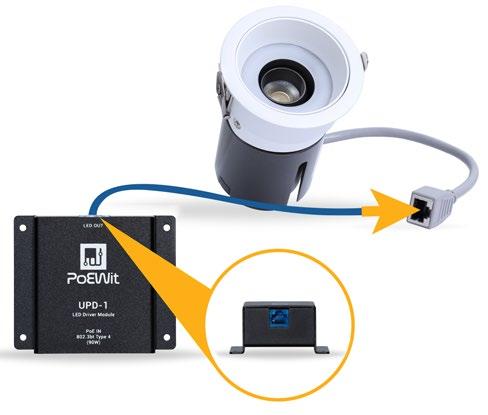
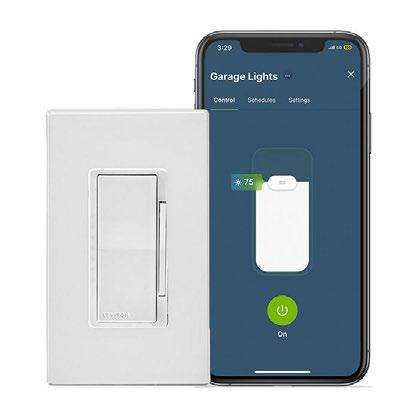
and kitchens or to adjust lighting in small business applications like restaurants or doctor’s offices.
Lux by Control4 presents a carefully curated palette of premium faceplates in a broad array of finishes and colors. This expanded range allows customers, including lighting designers, interior designers, and architects, to personalize keypads, dimmers, and outlets to perfectly complement their interior spaces, ensuring seamless integration into any design vision. At the core of Lux by Control4 is a dedication to precision engineering and cutting-edge technology. Control4 has adopted a new laser engraving process for keypad buttons, utilizing an advanced system to achieve exceptional detail and clarity — including customizable icons and text that enhance usability. The Lux by Control4 patent-pending dimming technology delivers superior current and voltage control for strong performance across a wide range of lighting loads, including LEDs up to 600 watts.
Developed with City Theatrical, the Environmental Lights Eluxtra ProFlex line of premium LED linear lighting products is characterized by exceptional craftsmanship and extreme durability, making these products ideal for indoor and outdoor installations. Eluxtra ProFlex is available in two form-factors: LED Strip Light and LED Neon. To cater to a wide range of applications, LED Neon is available in a classic neon profile, as well as a wide-top profile that is wider and taller, enhancing visibility from all viewing angles. Eluxtra ProFlex is offered in monochrome, tunable white, RGB, and PixelControl to create dynamic effects and smooth color gradients.
The Revelite CL-6 boasts a sleek design with robust performance. It is adjustable in order to shape the illumination pattern for each unique piece of art, while delivering an even distribution of light for a range of shapes and sizes. The clean design integrates into any space, providing even illumination while keeping the focus where it should be on the art. This fixture can be surface-mounted or flush-mounted, and there’s also a mud-in recessed mount option. The CL-6 is available in 2700k and 3000k using an LED selected for its high CRI — and more specifically a high R9 — value.
The AiSPIRE ATMOSPHERE 2.5-inch Tunable White Demo Tool Kit allows custom integration professionals to demonstrate the power and beauty of tunable white 98 CRI to interior designers, architects, and luxury home builders in their own offices. ATMOSPHERE from AiSPIRE offers options that create personalized and meaningful experiences for CI clients.
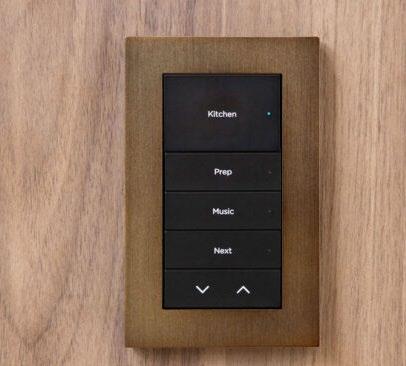
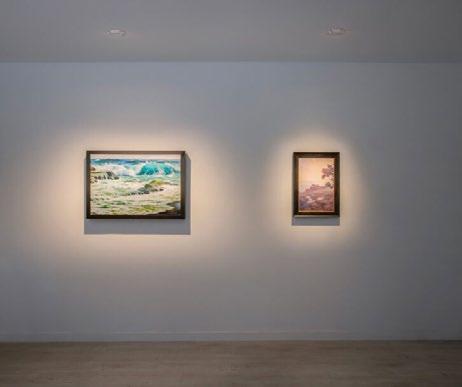
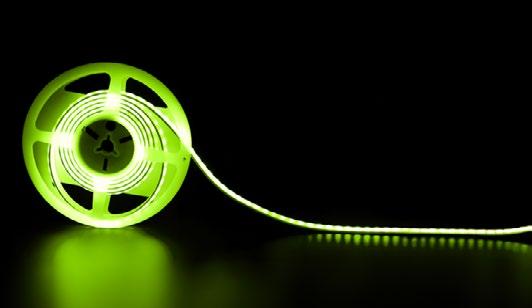

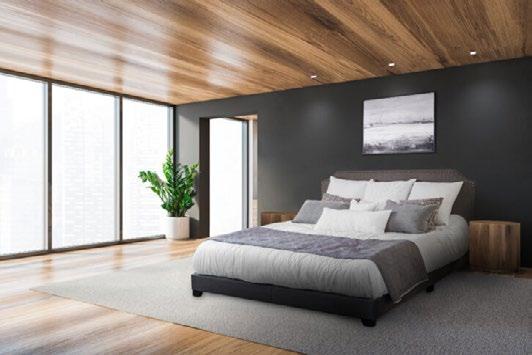

PowerShades has expanded further into the smart-home ecosystem with PowerShades Smart Lighting. PowerShades Smart Lighting is available in both downlighting and Flex RGBW strip lighting, plus assorted sizes, styles, colors, and beam angles. Downlighting has been designed to be completely agnostic of the control system, making it extremely versatile. They have a very smooth dimming response and are dimmable down to 1%. PowerShades Smart Flex RGBW Strip Lighting can be scheduled to coordinate with the user’s automated shades according to the sun position at the geographic location of the install — with brightness and color temperature adjusting to compensate for sun color and brightness throughout the day and particular season.
Luminii STENOS Micro-Optic Lighting features an advanced and proprietary micro-optic CSP engine, delivering uniform light output, high CRI, and exceptional glare control across an offering of downlight and track systems. Integrators will appreciate the ease and flexibility of the Stenos product range, which covers a wide range of applications for both commercial and residential spaces. Consisting of four discreet microdownlight profiles available in a 1-inch square, and in 3-, 5-, and 12-inch linear in both trimmed and trimless, STENOS downlights produce an output range of 250-1260 lumens, include 4 CCT options, Dynamic White, and 95+ CRI. All linear downlight options feature a ±30-degree aimable tilt, perfect beam quality, and magnetic beam shaping accessories, including optic + glare control louvers for 15-, 30-, and 60-degree beam options, and wall wash for the 5- and 12-inch profiles.
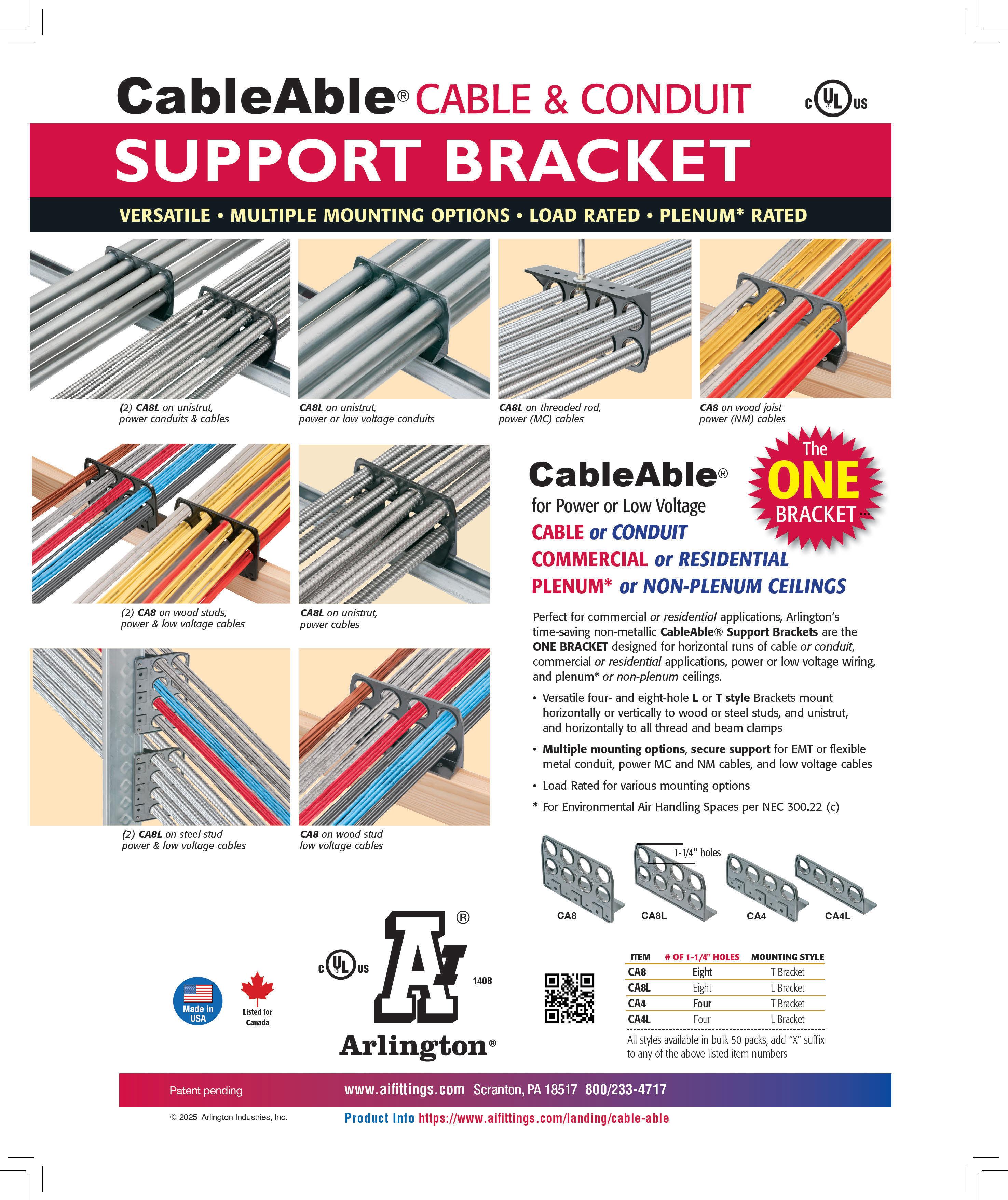
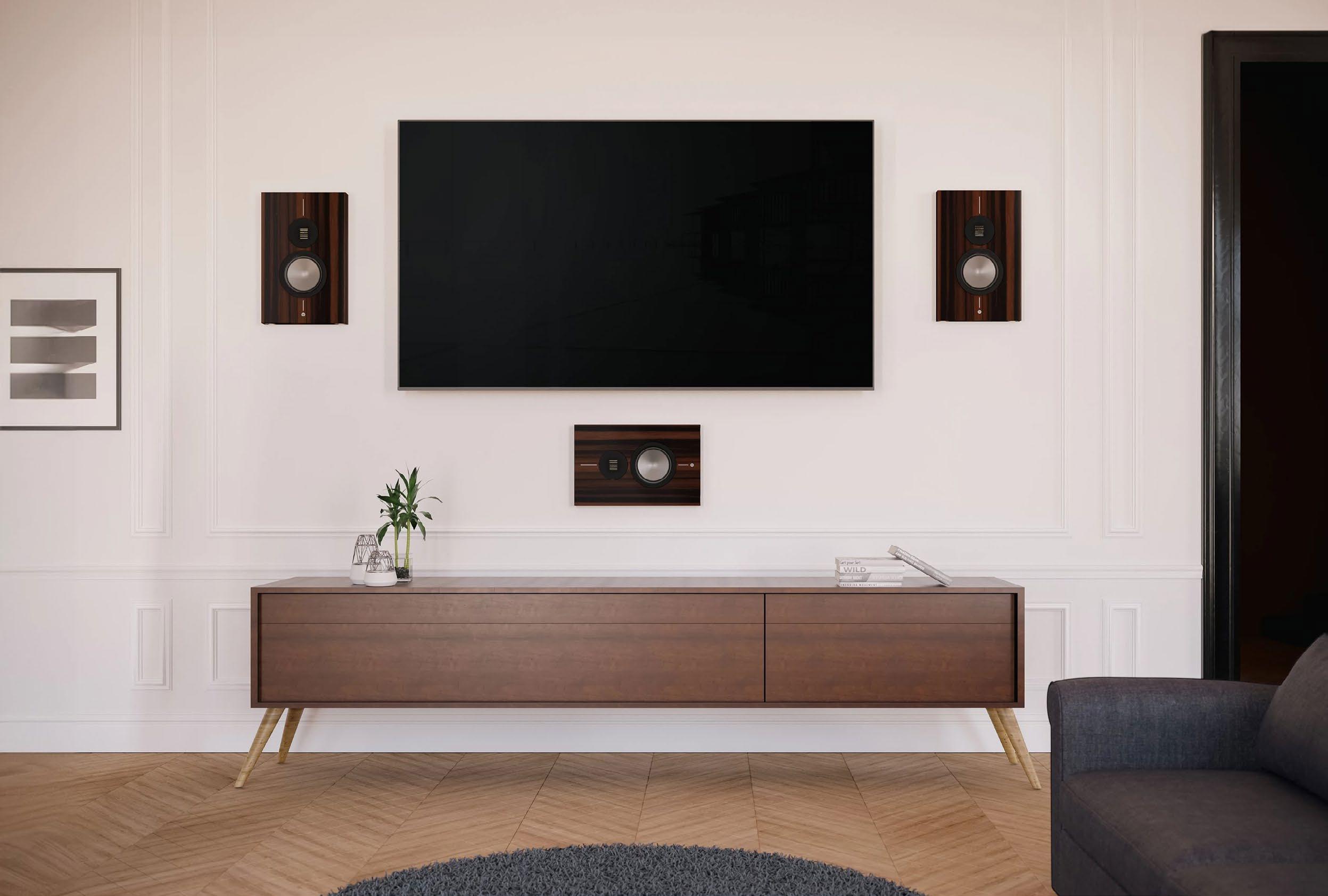
Today’s whole-home audio products present homeowners with a variety of listening spaces in discreet, flexible systems.
By Karen Mitchell
s more homeowners understand the benefits of quality audio throughout their homes, installers are seeing greater opportunities in whole-home audio. Introducing distributed audio to clients is the first step to successful projects.
“The best approach to introducing whole-home audio is by understanding what the client expects from any kind of amplifier or sound system, and addressing what functionality they want today and what functionality they may want tomorrow,” says Mark Zoran, owner, Imperial Security and Wiring. “But even more so, by explaining the future-ready capability of solutions such as Crestron DM NAX Audio-over-IP and DM NVX AV-overIP, giving them the ability to manipulate, update, upgrade, or change later as their needs evolve.”
When it comes to budget, Zoran knows a lot of builders and customers have heard the name Crestron and see it as an expensive option. So, when a customer asks why they should buy a $6600 amplifier from Crestron
when they can buy eight of the competitor’s amps for $700 apiece, Zoran is ready. “I explain, ‘Well, that’s because they’re almost the same cost if you break it down by room,’” he says. “‘But consider this: Crestron has native integration with X, Y, and Z streaming services, even right from your phone. Additionally, the competition is giving you a year-long warranty on a product that may require an upgrade every five years. Compare that to a Crestron product that will last you 10, 15, or even 20 years, depending on what you want out of it. So, the $900 or $1000 difference in the two products is inconsequential when you already have to upgrade one of them in five years and the other one you’re going to be upgrading in 20. Disney, the Pentagon, NASA, and the White House wouldn’t be using Crestron in their systems if they had to upgrade it every three to five years.’”
For home audio, Imperial is currently installing the DM NAX Audio-over-
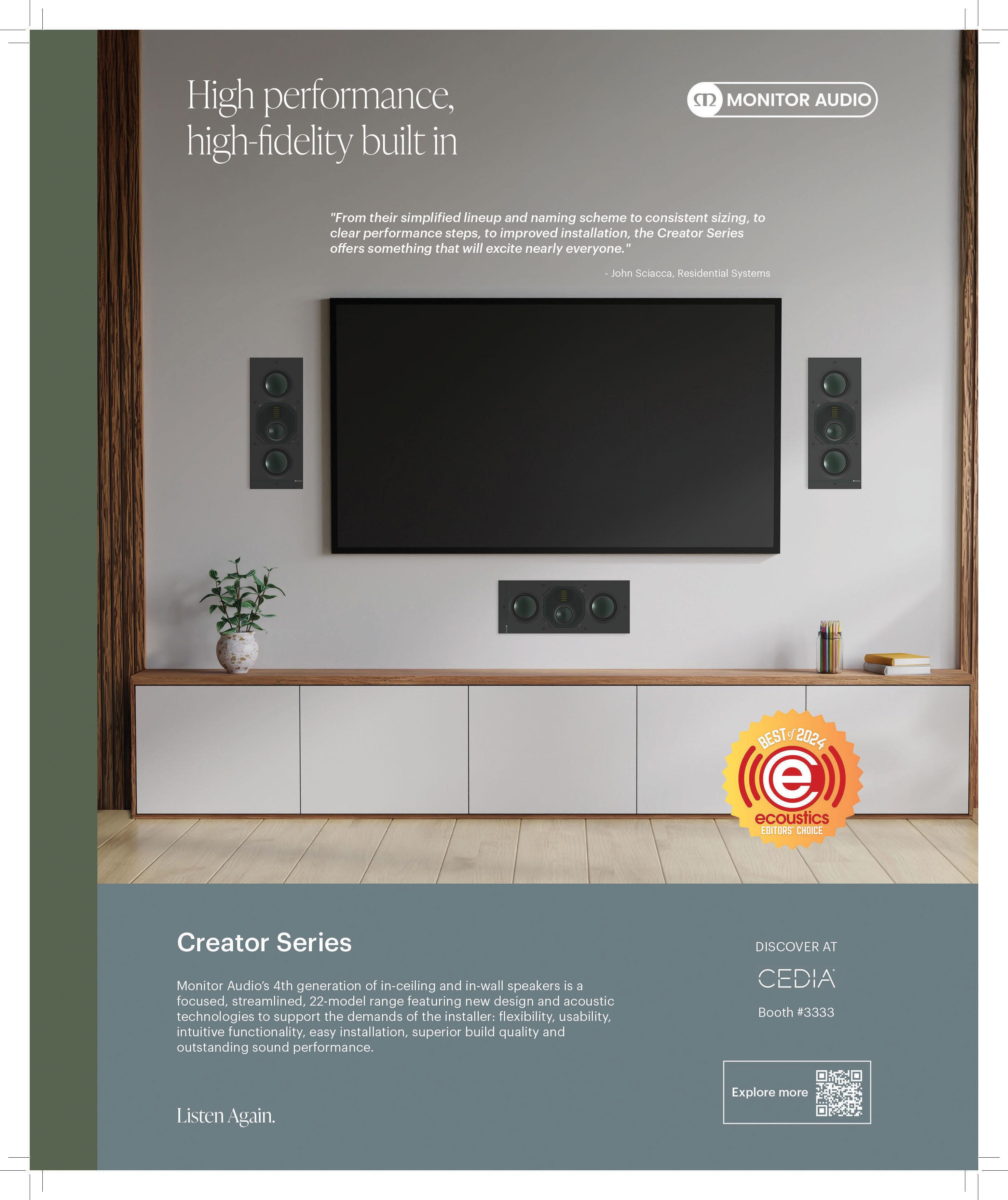
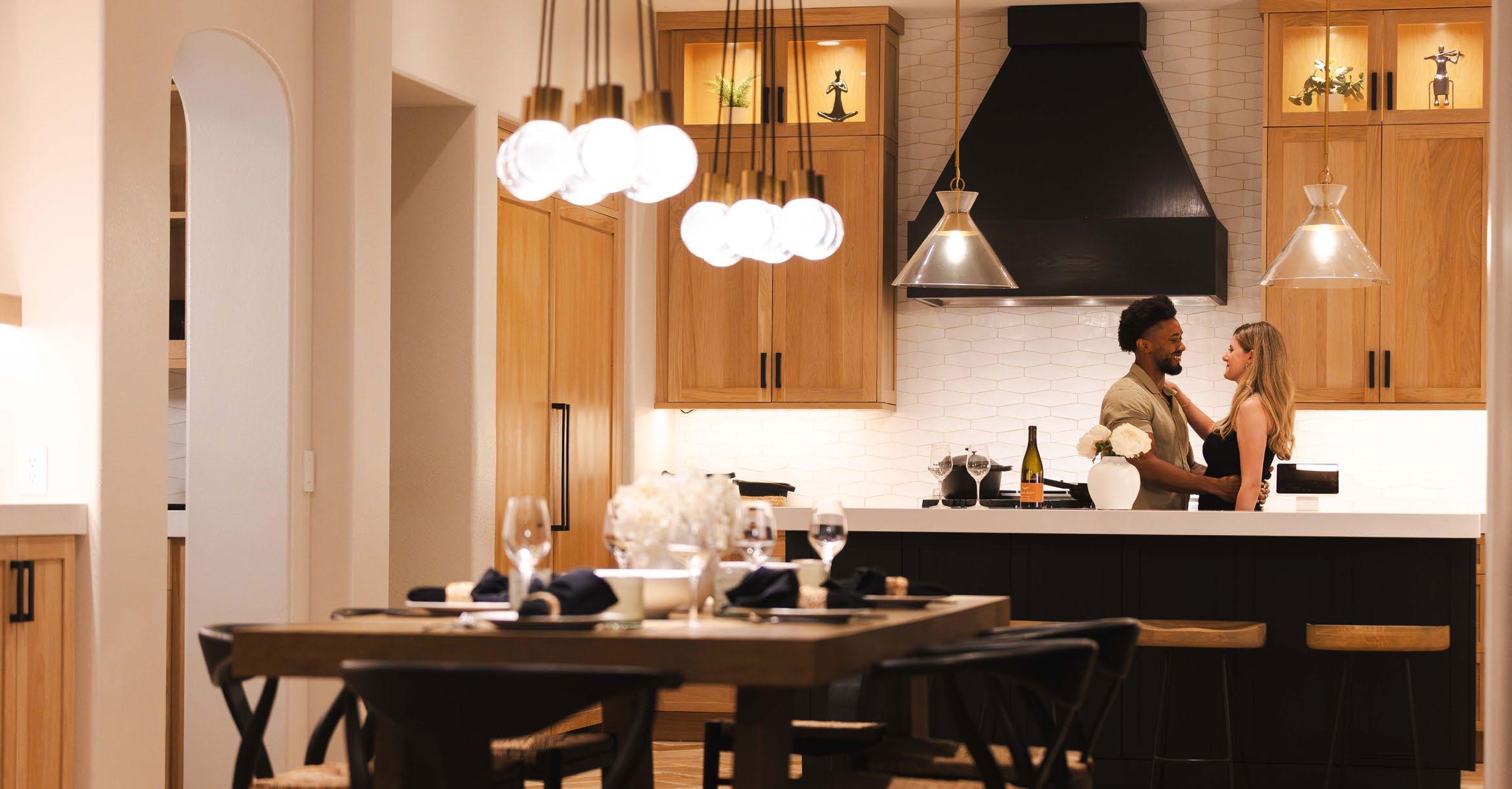
IP almost exclusively, he says. “We like the simplicity of installation, the ease of use, and the ease of interoperability, as well as the future-proofing that comes with this technology. It’s able to take multiple devices, multiple different inputs —even from things like phono players — and get them on the network. We have people who have massive, massive record collections, and they can add a record player and hear it throughout their house. We’ve got customers who have live music. They have pianos and hire pianists to play in their home for events. They can pipe that through the house. That’s not something you can do easily with many competitors’ products.”
There is also the ability to pipe in audio from a TV without using DM NVX. “You can add a couple of TVs that way, so you’re not using additional amplifiers to get TV audio through the system,” Zoran notes. “You can use the onboard coax, optical, or even analog output, depending on the age of the television. It gives you flexibility you don’t get from any other system for nearly the same price.”
Ask the customer direct questions, such as whether they spend most of their time in the back half of their home and whether they like to entertain often, advises Rick Lennon, brand manager for Kevro Inc., owner of Monitor Audio. “Explore indoor and outdoor needs, number of zones, and preferred sources such as Spotify, Apple Music, TV audio, and so on,” he says. “Customers are asking for integration with smart home systems and wireless flexibility, such as Sonos and HEOS. They also want a minimal visual footprint for in-ceiling/in-wall speakers as well as a setup for outdoor zones with patios and gardens. Voice and app control, such as Alexa and Google Home, are also discussed. The back half of the home, including kitchen, media, and family rooms, and the main zones, has the bestsounding speakers, which can address budget concerns.
“Monitor Audio offers a range of comprehensive high-fidelity, custom installation speakers and electronics to power multi-room serious home
cinema and stereo systems, as well as outdoor all-weather audio systems,” he adds. “Our Creator Tier 3 speakers offer our most advanced CCAM driver technology. RDT III bass driver, IDC II midrange driver, and IDC II tweeter with UD Waveguide II. Creator also has a revolutionary Quik-Link speaker cable connector and Tri-Grip II for quick, simple, reliable installations.”
Sonance doesn’t introduce whole-home audio by leading with specs or speaker counts, but by starting with talking about how sound fundamentally shapes the experience of living in a space, says Courtney Santana, senior marketing manager. “Clients may not ask for ‘distributed audio,’ but they consistently ask for homes that feel more comfortable, more beautiful, and more enjoyable,” she says. “From our perspective, the most effective way to do that is by anchoring audio in lifestyle and design, not hardware. Whether it’s music drifting through the house during a dinner party or a calming playlist in the bath, we help clients imagine the way sound fits naturally into their daily rituals.”
The Sonance Design Gallery and showroom finish boards allow clients to see and feel how seamlessly audio can be layered into their design. “When we lead with experience, budget concerns shift,” says Santana. “Clients begin to see audio not as a cost, but as an essential element of making their home feel like a home.”
Sonance is seeing strong traction with two standout solutions: the Sonance Small Aperture Series and their soon-to-launch UA Series DSP Amplifiers. “The new Sonance Small Aperture models expand our architectural audio offerings with a compelling option that balances performance, aesthetics, and ease of installation,” Santana says. “It bridges the gap between the Sonance Visual Experience in-ceiling line and the flagship James SA68 Small Aperture. These models deliver full-range performance in a discreet 4-inch round or square footprint and include a suite of installation aids like pre-construction bracket, multiple spacer options, and sleek trims.
Installers appreciate the foolproof mounting options, while designers love the consistent grille sizes that match downlights and architectural finishes. It’s a product that blends form and function seamlessly.”
Coming just in time for CEDIA, the UA Series DSP Amplifiers (UA 2-125 and UA 2-125 ARC) are purpose-built for local zone and TV audio applications. “These compact 2-channel amps deliver 125 watts per channel at 8 ohms, or 250 watts in Shared Power Mode — with headroom to spare for most speaker pairs and even subwoofer applications,” says Santana. “Installers benefit from a T-slot chassis for flexible mounting, plus onboard DSP tuning, app-based setup, and an eARC-capable model for simplified TV integration. These amps are ideal for applications like Sonance Patio Series systems, TV audio zones, and any environment where size, configurability, and performance all matter. In our opinion, these two product families represent the next generation of what Sonance does best: enabling high-performance sound that integrates beautifully, installs cleanly, and ultimately disappears into the design of the space.”
Every home tells a different story, and each presents its own acoustic, architectural, and finish challenges. “Condos may offer tight access and structural limitations; custom homes often involve balancing input from designers, builders, and clients,” Santana explains. “These variables demand both technical rigor and design sensitivity. Our most successful projects begin with early collaboration. Being involved during the design phase allows us to optimize speaker placement, wire paths, and integration opportunities long before finishes are selected. That timing is crucial for achieving consistent, high-quality results.
“We approach every layout with an emphasis on even, balanced audio coverage, not just decibel levels,” she adds. “The goal isn’t to flood a room with volume; it’s to deliver an immersive sound experience that feels natural in every corner of the space. A critical part of that experience is hidden bass. Integrating subwoofers strategically into cabinetry, walls, or ceilings adds a layer of warmth and depth that transforms the system from simply audible to truly enveloping. When done right, bass can be felt rather than seen, enhancing mood and presence without any visual distraction. Teams also rely on visual tools like the Sonance Design Gallery and showroom finish boards to help clients and design partners envision how sound will blend with materials like wood, plaster, or drywall. That clarity builds trust, reduces surprises, and sets expectations long before the first speaker is installed.”
Meeting the designer’s needs with small aperture or invisible speaker solutions is a top installation technique for success. “Prioritize by zone,” Lennon says. “Start with high-use areas such as living rooms, kitchens, and outdoor spaces.”
What’s most important is to set expectations from the beginning, understanding what the client actually wants. “Most people today expect a distributed audio system to be able to play multiple things in multiple rooms at multiple volumes, but some clients want a singular source in a singular zone,” Zoran says. “Sometimes you have to focus on the options or the integration that specifically suits their needs and wants as opposed to giving them every bit of every functionality and every possible option. Many people don’t need the doorbell integration with DM NAX Audio-over-IP, in which the speakers can become the doorbell.
“Sometimes a third-party does an update without telling Crestron about it, and Crestron has to pick up and put out a patch,” he adds. “When Crestron puts out an update, they update their own gear. With the free
firmware updates that Crestron provides, you know you’re always going to have the latest and greatest updates, and systems that just continue to work together. The Crestron Home OS really proves it: They’ve been able to update systems that were 20 years old with a new processor for pennies on the dollar compared to full custom jobs.”
Going forward, the trend is to add more features and functions to these systems. “As integration gets deeper and deeper into homes, people are looking for more ‘one-fit’ solutions that can accommodate an ever-changing landscape in the world of AV, and DM NAX technology truly is one of those solutions that navigates that terrain perfectly,” Zoran notes.
“Sonance believes that technology should disappear, not distract,” Santana says. “Homeowners today want spaces that are both beautiful and functional, and they expect technology to enhance, not interrupt, that balance. The future of audio isn’t louder. It’s smarter, more invisible, more intentional. We design for experience, using layers like balanced coverage, hidden bass, immersive sound channels, and intelligent DSP correction to make every system feel custom to the client and their lifestyle. When done right, the technology fades away. What’s left is a space that sounds, looks, and feels exactly right.”
Lennon sees the future of whole-home audio in on-wall, highperformance speaker solutions that focus on discreet, high-fidelity audio with slimmer designs and smart home compatibility. “We provide two on-wall options in traditional box speaker lines: Gold On-Wall 6G and Bronze On-Wall 7G,” he says. “We also see the integration of AI with smart home technology and a move toward hidden and integrated speakers for a minimalist aesthetic that doesn’t compromise sound quality.”
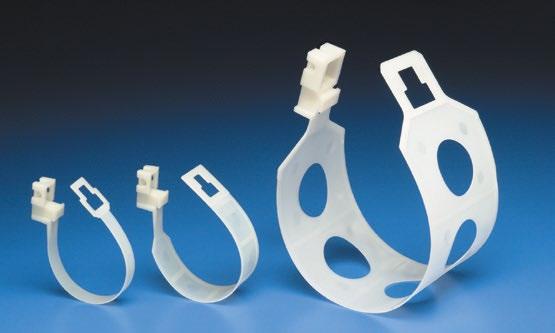
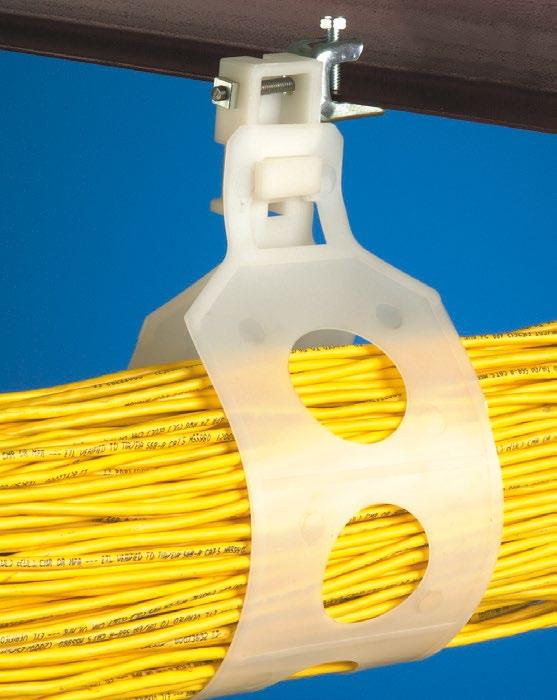

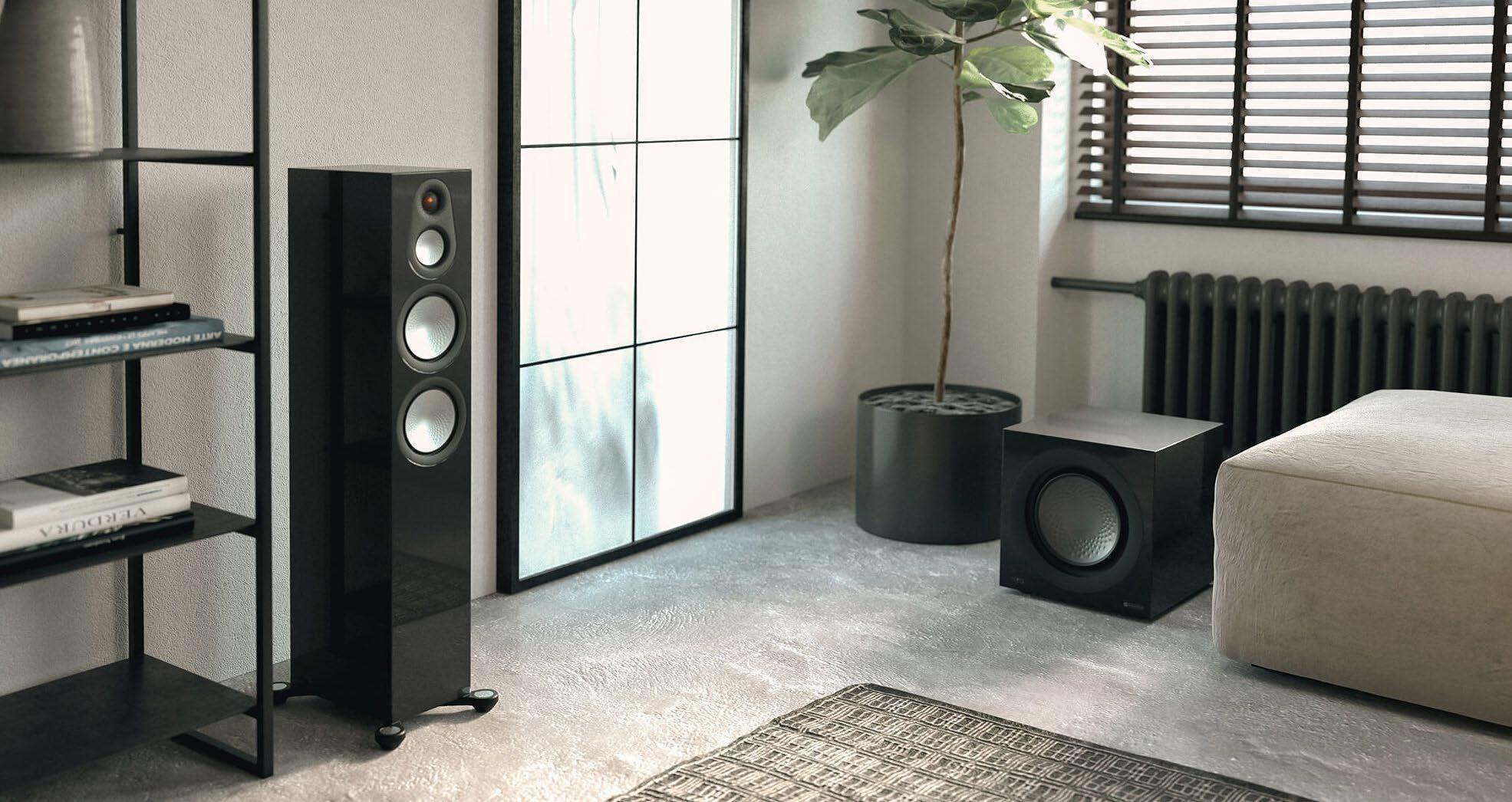
Tips on finding the perfect spot to create the low-end vibe you are looking for.
ant to experience that deep, visceral low-end that makes music and movies truly immersive? The subwoofer is the vital element that delivers the magic of well-reproduced bass. However, the journey to sonic perfection doesn't end with the purchase; it requires understanding how to integrate this powerful tool within your listening environment and appreciating the impact of something as fundamental as placement. Forget simply finding a spot that fits — proper subwoofer placement is a crucial element in the art and science of audio, requiring a touch of knowledge and a willingness to experiment.
Before we delve into placement strategies, let's quickly understand how subwoofers operate and why their location is so critical. Subwoofers are specialized speakers dedicated to reproducing low-frequency sounds, typically ranging from 20 to 200 Hz. They achieve this by using large drivers (woofers) that move a significant amount of air, generating powerful bass waves. This is the kind of sound you don't just hear but feel — the chest-thumping impact of a drumbeat or the room-shaking tremor of an explosion. However, these low-frequency bass waves behave quite differently from
the mid- and high-frequency waves produced by your main speakers, whether these be floorstanding or bookshelf speakers. Bass waves are much longer, causing them to interact with your listening room in complex ways. Walls, floors, and ceilings become reflective surfaces, leading to bass waves bouncing and interfering with each other.
This interference can create standing waves, resulting in areas of amplified bass (peaks) and areas of diminished bass (nulls) within your room. The consequence? Uneven bass response, where some spots sound fantastic, while others lack impact or sound overly boomy. This is why the optimal subwoofer placement isn't always obvious and why careful positioning is paramount for achieving accurate and enjoyable bass reproduction.
What is the ideal placement for the subwoofer? How do you pinpoint the ideal location for your subwoofer within your unique listening environment? Let’s walk through a couple of methods you can put into practice:
This seemingly unconventional method could be argued to be one of the favorites among audiophiles. Because low frequencies are so heavily
influenced by room acoustics, the subwoofer's position dramatically affects the bass you perceive at your listening position, so, instead of guessing, get down on your hands and knees and use your ears!
By physically moving around the room while a bass-heavy track or test tone plays, you can identify the spot where the bass sounds the smoothest, most even, and most balanced.
The logic is simple: a location that sounds good when your ears are where the subwoofer normally sits is likely a good spot for the subwoofer itself.
How to perform the subwoofer crawl:
1. Temporarily place your subwoofer in your primary listening position.
2. Play a track with consistent bass content or use a dedicated test tone.
3. Crawl around the room, listening intently to the bass response at various locations—corners, along walls, and in the center.
4. Mark the spot where the bass sounds the most consistent and articulate.
5. Move your subwoofer to this marked location.
It's a common misconception that placing your subwoofer directly against a wall or in a corner maximizes bass output. While boundaries like walls and corners can indeed reinforce bass, this often comes at the expense of clarity and definition.
Subwoofer placement in these areas can excessively excite room modes, leading to boomy, indistinct, and muddy bass that obscures detail. For cleaner, more defined, and musical bass, experiment with pulling your subwoofer away from walls and corners.
Even a small distance can make a significant difference, allowing the bass waves to develop more naturally.
Many audio experts suggest starting with subwoofer placement on the same wall as your main speakers, toward the front of the room. This can aid in integrating the bass with the rest of the soundstage, creating a more cohesive and natural listening experience where the bass seems to originate from the same general direction as other frequencies.
However, don't hesitate to experiment with placing your subwoofer along a side wall. In some rooms, this can yield a more even bass response throughout the listening area, minimizing those problematic peaks and nulls. Remember, there are no rigid rules, and experimentation is often key to finding the optimal spot.
In larger or irregularly shaped rooms, achieving consistently good bass response with a single subwoofer can be challenging. If you're serious about your audio and desire truly even bass distribution, consider the benefits of adding a second (or even more) subwoofer.
Strategically placed dual subwoofers can effectively minimize dead spots and standing waves, creating a more immersive and balanced bass experience across the entire listening area.
Potential placements for multiple subwoofers include opposite ends of the front wall, along opposing side walls, or even diagonally across from each other. While requiring a larger investment, this approach can significantly enhance your audio enjoyment, particularly for home cinema setups.

Once you've found a promising location for your subwoofer and connected it to your system, the journey isn't over. Fine-tuning its settings is crucial for seamless integration with your main speakers and achieving the most accurate and impactful bass response. Pay close attention to these common subwoofer controls:
• Crossover Frequency: This setting dictates the highest frequency your subwoofer will reproduce. Frequencies above this point are handled by your main speakers. Setting it correctly ensures a smooth transition between your speakers and the subwoofer, preventing gaps or overlaps in the frequency response. A common starting point is around 80 Hz, but the ideal setting depends on the capabilities of your main speakers.
• Phase: The phase control helps align the subwoofer's output with your main speakers at the crossover frequency. If the bass sounds weak or muddy or seems to come from a different location, experimenting with the phase setting (usually a switch or knob adjustable between 0 and 180 degrees) can improve integration.
• Gain (Volume): This control adjusts the overall output level of the subwoofer. The subwoofer should complement, not overpower, your main speakers. Adjust the gain to achieve a balanced and natural sound where the bass enhances the overall listening experience without being boomy or distracting.
• EQ (Equalization): Some subwoofers offer built-in equalization controls, either with presets or custom options. These can be invaluable for further tailoring the bass response to your specific room acoustics and listening preferences, allowing you to tame unwanted peaks or boost areas where the bass might be lacking.
Ultimately, finding the ideal subwoofer placement is a personal journey of discovery, influenced by your unique room, listening preferences, audio equipment, and even the type of content you enjoy.
There's no universal "best" spot. However, by understanding the principles of subwoofer positioning, employing these techniques, and dedicating time to experimentation and fine-tuning, you can unlock the full potential of your audio system.
The reward will be a truly immersive and engaging listening experience, where the bass is not just heard but profoundly felt, adding a new dimension to your enjoyment of music and movies.
This article was provided by Monitor Audio. For more information, visit https:// www.monitoraudio.com.
For its latest projection family launch, Epson talked with and polled dealers, and visited different markets to find out what custom installers actually want in its new 4K HDR laser projector lineup. Turns out, we wanted five things from Epson: [1] More CI-channel-dedicated products; [2] Higher price points; [3] Best-in-class dealer margins; [4] Better availability; and [5] Better dealer resources.
The result was Epson’s new Premium Residential models QB1000, QL3000, and QL7000 launched at CEDIA Expo 2024. All these models are designed to take Epson’s highbrightness commercial projection expertise to the upscale residential market. The QB1000 (reviewed here) clocks in at 3300 lumens, the QL3000 at 6000, and the QL7000 at an eyemelting 10,000.
Epson’s senior product manager of home entertainment, Melvin Diaz, said that the Q-Series’ high brightness is designed to deliver in three key areas: [1] Deliver a larger scale viewing experience than traditional flat panel TVs; [2] Enable installations in brighter, mixeduse environments, and [3] Drive an impactful HDR experience, all within a sleek, designconscious form factor.
Having seen these three models in action when they were unveiled at CEDIA, I was interested to give the QB1000 a run in my own theater and see how it held up in actual realworld use.
To be more multi-use friendly, all three of the models are available in either matte black or white case finishes, and Epson sent along the white model for review. Since my projector is in my great room, the white Epson was definitely
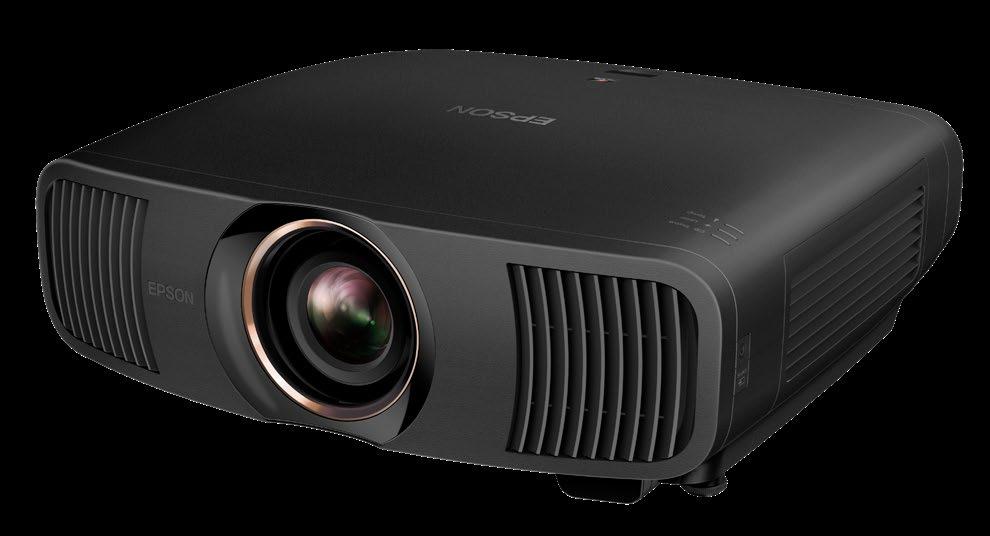
more décor-friendly than the black projector I currently have hanging.
The next thing I noticed was the motorized lens/dust cover, which is closed to keep the lens protected when not in operation. Seeing my normal lens just sitting out in the open, unprotected and gathering dust, has always been a pet peeve of mine, so I love this feature.
Diaz said that Epson’s Q-Series home projectors are designed to be quieter than commercial models, requiring a different chassis and cooling design. I liked that the cooling system draws air in through the sides of the unit and exhausts it out the front, letting you place the projector right up against the back wall if needed without any fear of overheating.
As with all of Epson’s 4K projectors, the QB1000 is a 3-chip, 3LCD design that uses three individual LCD driver chips and three individual LCD panels each dedicated for red, green, and blue primary colors to display 100% of the signal for every frame. However, these are all 1920x1080 resolution chips, so getting the full 8.29 million pixels on screen for 3840x2160 4K resolution requires the use of a technique called “pixelshifting” and a Precision Shift Glass Plate that Epson refers to as “4K display technology.”
This means that every pixel’s image is rapidly shifted four times diagonally and horizontally, allowing each individually addressable pixel to be displayed. This process happens at an extremely high cycle rate, quadrupling the visible pixels on screen to produce the 8.29 million pixels of 4K. This is opposed to the native 4K chips used by manufacturers like Sony and JVC, which don’t require pixel-shifting technology.
A couple of noted bits of technology make these new models possible. One is a newgeneration, high-efficiency laser light source, which can achieve higher brightness in a smaller size. Epson claims that the laser light engine
is 75% smaller, as well as quieter than previous designs, again making them more usable in a wider number of installation applications.
The QB1000 claims a sub 32 dB fan noise output level at 100% laser brightness, which drops quieter when at 85%, and as quiet as 22 dB at 50% brightness.
Another big improvement in this lineup is Epson’s new proprietary QZX Picture Processor, the company’s most powerful video processing technology to date. This 32-bit chip handles real-time color, dynamic contrast, scene adaptive gamma, HDR, 4K pixel-shifting, frame interpolation, dynamic tone mapping, and resolution super-sampling to most accurately and faithfully reproduce the source material.
Connections are all on the back of the unit, which keeps the sides clean. If you’re a stickler for no visible wires, the unit comes with a rear panel cover that will conceal all the connections, but does add about 2 inches to the depth. And while they will likely be used sparingly, I did love that Epson included a full suite of D-pad controls on the back of the unit, including a Menu and Lens button that will allow you to perform all operations directly from the unit itself. A menu setting even lets you invert the direction buttons on the unit when controlling the OSD from the unit when it is ceiling mounted. Smart!
The projector includes two HDMI 2.1 inputs that are full 40 Gbps bandwidth and can accept both 2K/120 and 4k/120 signals. Interestingly, HDMI 2 is eARC-capable, letting you connect the projector directly to a soundbar or other system, like Sony’s Theater Quad. Also interesting is that the eARC connection supports HDMI-CEC control, so you could control a connected CECcapable device.
The HDMI inputs feature ALLM (Auto Low
By John Sciacca
High brightness; tons of menu/settings options; impressive HDR performance; massive placement flexibility
All the memories can be confusing; full laser off only works in Dynamic; some upscaling twitter; no tweaks to DTM settings
3-chip 3LCD laser engine video projector with 3840x2160 (dual-axis 1920x1080) resolution
3300-lumen color (IDMS Rated) and white light output (ISO Rated)
15-element precision glass structure VRX lens
Motorized lens system with 1.35-2.84 throw ratio along with ±96% Vertical and ±47% Horizontal lens shift
20,000 laser lifespan (to halfbrightness)
HDR10, HDR10+, and HLG support with Automatic Dynamic Tone Mapping
Inputs: Two HDMI 2.1 (HDCP 2.3, one supporting eARC), two USB-Type-A, Mini USB (service), RJ45 LAN, RS232 DB-9, 12-volt mini-jack trigger; Outputs: Detachable power cord
Dimensions: 20.5 x 7.6 x 16.6-inches (WxHxD, excluding rear cable cover); Weight: 28.2 pounds
Latency Mode) for gamers, with a reported input lag time below 20ms.
With its UltraBlack technology, a proprietary compensation filter that controls the polarization of light, the QB1000 can produce a Dynamic Contrast Ratio exceeding 5,000,000:1.
But the big new feature to the QB1000 is video processing that analyzes content on a frameby-frame basis in real-time, called Dynamic Tone Mapping (DTM). In addition, the QB1000 also supports HDR10+, a dynamic HDR format akin to Dolby Vision. HDR10+ had previously been reserved for a handful of UHD Blu-ray disc releases, however, several major streaming platforms such as Netflix, Disney Plus, Apple TV,
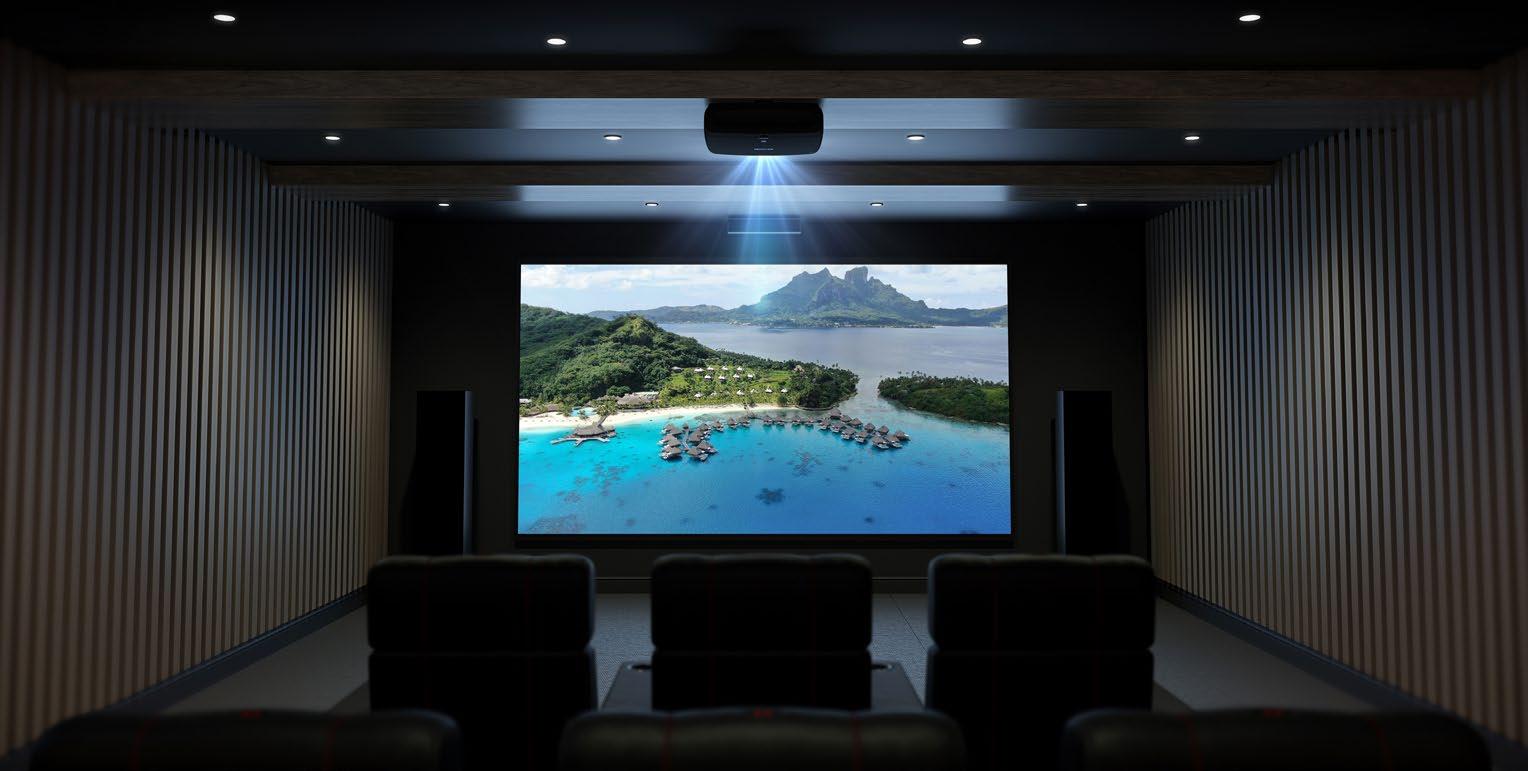
and Prime Video have started streaming content coded with HDR10+ metadata, so this feature could become a compelling purchasing driver. It also supports the HLG — Hybrid Log Gamma — HDR standard.
As the name implies, DTM optimizes brightness on a frame-by-frame level, using signal processing to enhance the brightest areas on the screen to retain better gradation, contrast, and a wider dynamic range.
If you’ve read anything about projectors in the current HDR world, then you’ve doubtless run across the term “tone mapping.” Why is this so important for projectors? Theatrical content is mastered on studio monitors capable of reaching 1000 nits, with Hollywood’s workflow shifting to mastering monitors capable of displaying 4000 nits. The problem is most projectors would struggle to produce 350 nits. So, this content needs to be translated from 0 to 1000 (or even 4000, or up to 10,000) nits, to a range of 0 to 300 that the projector can reasonably handle. But this needs to be performed in a way that maintains both the bright and dark details in the image. When performed correctly, the image will retain the shadow details in dark images while retaining the specular highlights found in really bright images such as shots of the sun, lightning flashes, or snowy mountains. If a projector tone maps poorly, the darker areas or the brighter areas (or both) can be “crushed,” losing detail that was meant to be visible and having no subtlety.
Along with the HDMI connections, there is an RJ45 for connection to a LAN, a USB-A with 5V/2A to power a streaming device, a USB-A with 300mA to power an Optical HDMI cable, a miniUSB for service and backups/restores, an RS-232 DB9 connection, and a 12-volt mini-jack trigger, along with a detachable power connection. The trigger output is configurable to be always on,
useful for dropping a motorized screen, or only on when an Anamorphic mode is selected, useful for triggering a lens sled.
In addition to front and rear IR signal sensors, the QB1000 can be fully set up and controlled via IP, and supports PJLink, Control4’s SDDP protocol, and Crestron integration. The Control4 control library offers direct access to virtually every command and setting you might want, letting you give customers access — or preprogrammed commands — to switch to the ideal picture mode or setting when watching different sources, aspects, or resolutions.
The QB1000 is ISFCCC-certified with full RGBCMY hue, saturation, and brightness adjustments for each color. Further, there is a Color Uniformity option that allows tweaking grayscale color balance at different points on the screen.
The menu structure is well laid out, but has a lot of options. If you’re a tweaker and you like to dive into every setting and adjustment, settle in, because the QB1000 probably has exactly what you’re looking for!
As is the case with nearly all modern displays — projectors and TVs alike — the QB1000 doesn’t offer any 3D support.
The included remote is well-designed and is backlit for easier operation in a darkened theater. It has direct access buttons to many of the commands you’d use regularly.
The QB1000 can be either front-, rear-, ceiling-, or shelf-mounted. If you are shelf-mounting it, it offers two adjustable leveling feet so you can get it perfectly level and square. When ceiling mounting, the Epson utilizes four mounting holes, allowing for an easier time of squaring and leveling the unit to the screen, and its 28.2-pound weight shouldn’t pose any issues.

Vol. 26 No. 9 September 2025 residentialsystems.com


FOLLOW US twitter.com/resisys facebook/resisys CONTENT
MD, Content, AV Anthony Savona anthony.savona@futurenet.com
Contributors: Katye McGregor Bennett, Matt Bernath, Sam Cavitt, Henry Clifford, Dave Donald, Tim Fitzpatrick, Jason Griffing, Anthony Grimani, Karen Mitchell, Lisa Montgomery, Todd Anthony Puma, John Sciacca, Lisa Slayman, Gordon van Zuiden
Production Manager Heather Tatrow Art Editors Matt Lochrie & Rosie Webber
ADVERTISING SALES
Managing Vice President of Sales, B2B Tech Adam Goldstein, adam.goldstein@futurenet.com 212-378-0465
SUBSCRIBER CUSTOMER SERVICE
To subscribe, change your address, or check on your current account status, go to residentialsystems.com and click on About Us, email futureplc@computerfulfillment.com, call 888-266-5828, or write P.O. Box 1051, Lowell, MA 01853.
LICENSING/REPRINTS/PERMISSIONS
Residential Systems is available for licensing. Contact the Licensing team to discuss partnership opportunities. Head of Print Licensing: Rachel Shaw, licensing@futurenet.com MANAGEMENT
SVP, MD, B2B Amanda Darman-Allen
VP, Global Head of Content, B2B Carmel King MD, Content, AV Anthony Savona
Global Head of Sales, Future B2B Tom Sikes
Managing VP of Sales, B2B Tech Adam Goldstein VP, Global Head of Strategy & Ops, B2B Allison Markert VP, Product & Marketing, B2B Andrew Buchholz
Head of Production US & UK Mark Constance Head of Design, B2B Nicole Cobban FUTURE US, INC.
130 West 42nd Street7th Floor New York, NY 10036

As it was a review sample that would not be a permanent resident in my theater, I set the QB1000 on a box in my kitchen, which happens to line up centered on my screen. Once I got it square and level to the screen, installation was as simple as adjusting the lens to fit and focus on the screen.
The QB1000’s lens has a zoom ratio of 1:2.1 and a throw ratio range of 1.35:1 to 2.84:1. This means for a 100-inch, 16x9 image, the projector could sit anywhere from 118 to 248 inches from the screen, and for a 150-inch image, it could sit from 178 to 373 inches. It also offers a vertical lens shift of ±47%, and a horizontal shift of ±96% if you can’t get it positioned dead center. This generous range should give it the ability to replace almost any existing projector at the same location.
While you should never use it, the Epson offers a host of keystone and geometry adjustments that will insure you can get the image digitally square on screen if you can’t position it correctly. This includes a ±30-degree vertical/horizontal, a Quick Corner, and a Point Correction adjustment that lets you dial in multiple areas on screen. But remember, even a single click of keystone correction can crush your fine resolution detail and introduce artifacts, so don’t use it.
I have a dual-aspect Draper M1300 motorized screen that is 92 inches (16x9) and 115 inches (2.35:1) diagonal. Because of this, the fully motorized, 15-element precision glass VRX lens with memory is a fantastic and much needed feature in my install. The QB1000 also allows you to store 10 different lens memory positions that saves lens shift, zoom, focus, and blanking settings. You can rename these settings so you’ll know which to recall for the variety of aspect ratios employed by modern directors and streaming services. I typically set up memories for 16x9, 2.0x1, and 2.35x1, but with 10 available, you could get as granular as you want.
For those with an anamorphic lens, the Epson has Anamorphic Wide and Horizontal
Squeeze settings, which stretch the image vertically or compress the image horizontally. Another great install feature is the panel alignment that lets you tweak the Red and Blue LCD panels at multiple points on screen for the most accurate alignment. Like the old point adjustment on CRT projectors, you navigate a grid pattern on screen and align the red and blue panels for the sharpest image. This process can take a few minutes to complete, but it certainly can make tiny details and things like text sharper with less color fringing. I also love that Epson includes three separate panel-alignment memories, letting you adjust and store them separately for different lens zoom positions.
In addition to the lens and panel alignment memories, there are also 10 Picture Memory settings that store the color mode (Dynamic, Vivid, Cinema, or Natural), light output, and other picture settings, including any RGBCMY grayscale calibration. There are also five Image Preset Memories that save Noise Reduction, MPEG NR, Super-resolution, and Auto Contrast Enhancement settings.
Operationally, without a control system, getting these four memory settings — lens position, picture memory, panel alignment, and image preset — all selected for a given source/resolution/aspect could take quite a few button presses, and it would be nice if there were a way to save them all under a single recallable memory.
There are no separate SDR and HDR settings, so these will need to be adjusted individually and then saved as separate memories if desired. Epson’s technical account manager and projector guru, Robert Brennan, commented, “The best practice is for color adjustments to be made to SDR content. Based on these values, and using the internal 3D LUT (look-up table), HDR color values are determined.”
As mentioned, this is the first family of Epson projectors to employ DTM, but there is only an on or off setting for this. Both

JVC and Sony offer some tweaking to the DTM settings — essentially how aggressive you want the projector to handle the brightest and darkest parts of the image — but with the QB1000’s DTM you don’t. If you disable DTM, then there is a manual 1–20 slider for HDR processing that allows you to lower or increase the Average Picture Level.
The most accurate out-of-box setting is the Natural color mode, which most closely tracks D65, but it disables certain settings like DTR by default. Cinema color leaves these settings on, but is not as close to D65; however, this is where Brennan likes to begin by applying some specific tweaks to white balance, G-M Correction, color scale, and gamma.
The Dynamic mode is for max brightness, and it definitely delivers, but it has a noticeable green bias to the image. Vivid is also quite bright, but it comes with a noticeable blue tint. For viewing in bright rooms, or for customers that want the color to “go to 11,” these would do the trick.
I watched in Natural for the majority of my viewing, but made some tweaks to gamma (-2), DTM (on), and Frame Interpolation (low).
It's clear straight away that the QB1000 puts out a ton of light, and it was definitely viewable in my great room even with a fair bit of ambient lighting. Would I want to watch something with really dark content like Alien or 1917 during the middle of the day? No. Could I enjoy YouTube and sports? Absolutely. Of course, when the lights dropped, that’s when it really shined, pun intended.
The QB1000 delivers a sharp, detailed picture with great edge-to-edge focus. Things like the instrument readouts and displays in the Darkstar cockpit in the opening of Top Gun: Maverick, or words and files on computer monitors in Zero Dark Thirty were all visible, and there were tons of fine details in the intricate costumes of the dancing warriors on the boats as we first come into Wakanda in Black Panther. Large cityscapes and broad vistas also revealed loads of detail, with sharp resolution and crisp focus at all points on the screen.
I had been waiting to watch the new 4K HDR release of The Abyss: Special Edition, and finally pulled the trigger and bought it on the Kaleidescape store. It did not disappoint! The detail and sharpness of this 36-year-old film looked amazing, with none of the grain-scrub softness that was present in the Terminator 2 4K release. The QB1000 produced terrific
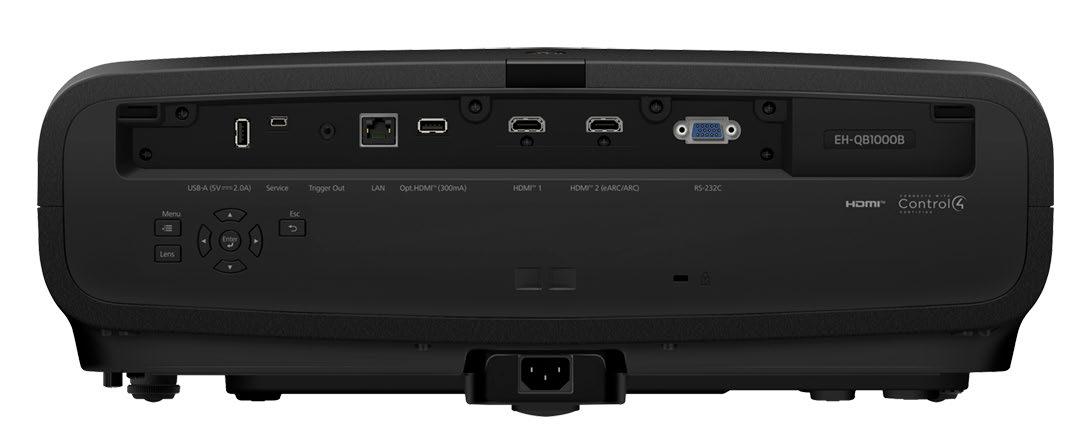
images, full of bright HDR highlights, and only exhibited the smallest bit of banding in some of the difficult underwater scenes.
Regarding the DTM, I found that even without the ability to tweak settings, the QB1000 did a mostly bang-up job. You can toggle it on/off and see the effect that DTM has on the image, and I nearly always preferred it on. Things like the big balls of fire and lightning strikes in Mad Max Fury Road or the dark “Waking Up in Écoust” scene in 1917 all looked better and preserved more detail with DTM on. Even the difficult, ultrabright scene from Alpha, mastered at 4000 nits, preserved much of the detail in the shining sun.
I was eager to see how the 4K pixel-shifting affected images compared to my native 4K Sony, so I started with a variety of test patterns from the new Spears & Munsil Ultra HD Benchmark discs. For the most part, the pixel-shifting handled these without issue, however there were times when there would be some slight strobing or flashing in the very finely detailed 1:1-pixel patterns.
In real-world viewing, the pixel-shifting rarely called attention to itself from a typical seating distance, however there are things that trip it up, and that’s usually tight vertical or horizontal lines when the camera is moving. During the opening of The Dark Knight, there is a window with a grate over it, and the grate has some noticeable shimmer. In Final Destination Bloodlines, one of the doomed characters is wearing a shirt with a tight vertical pinstripe, and these also exhibited that twitter. Other scenes like fine mesh or angled lines in gates or fences could exhibit these artifacts as well. Now, take this with a grain of salt; I’m specifically looking for these kinds of artifacts, so I’m more sensitive and aware of them. Would a typical viewer notice? Unlikely. However, compared to a native 4K projector, the QB1000 stumbled.
I felt the QB1000 benefited from having its frame interpolation set to low or normal as opposed to off. When off, there was noticeable blurring of things like scrolling credits or cars driving on a freeway. I felt low cleaned up this motion to a more natural presentation without
introducing the soap-opera effect or any other noticeable issues. With the “Sarah on a Hammock” scene from the S&M disc — probably one of the most torturous motion-handling clips — the QB1000 could smooth out the motion of Sarah swinging, but it was definitely at the expense of detail and noise and artifacts looking through the hammock.
Having lived with several laser projectors, one thing you get used to is the full-fadeto-black (FFTB) on an all-black scene. With the ability to instantly turn the laser on/off, this pitch to full-black enables an OLED like experience at times. (Admittedly, it can be a bit jarring, say during some credit scenes when there is a single name, black screen, single name, black screen, etc., which is why projectors give you the option of disabling the FFTB option.)
With the QB1000, the projector will only FFTB when in the Dynamic color mode. Fortunately, you could perform a full color calibration using the Dynamic mode and achieve accurate color and grayscale and keep the FFTB feature, but Epson not including that as an option for all color modes is disappointing.
Operationally, I have a couple of small nits. For one, closing most menu/adjustment settings requires three or more additional button presses to get back out of the menu. When I hit “Esc,” get me out of there and close the menu! (I eventually discovered that hitting “Menu” again is the way to close the OSD immediately.) Second, the Epson can be slow to resync the video when changing formats. This wasn’t an issue when watching broadcast television on Dish, but when watching YouTube content and going in/out of ads, or coming in/out of the Kaleidescape menu, the picture would go dark for several seconds.
The Epson QB1000 sets a new benchmark in the lumens-to-dollars category, delivering up to 3300 lumens to produce a dynamic HDR image. For multi-use installations that will be competing with ambient lighting, it offers a compelling argument over a direct view display, with images only getting better when the lights go down!
The four key product characteristics you need to create long-lasting and effective landscape lighting designs.
BY TIM RYAN, EXECUTIVE DIRECTOR AND PRINCIPAL LIGHTING DESIGNER, LIGHTHOUSE DESIGN STUDIO
Selecting the correct landscape lighting fixtures for your project requires more than just brand loyalty. While many professionals have a go-to manufacturer, every product should be evaluated based on key functional and aesthetic criteria to ensure long-term success. Here’s what to consider when specifying fixtures.
In most cases, landscape lighting fixtures should visually disappear into the environment. Finishes like dark bronze or black are ideal, as they blend naturally with mulch and plantings. Fixture size matters, too — modern LED technologies have made it possible to achieve powerful lighting effects from smaller, less conspicuous fixtures. This supports the principle of “seeing the effect, not the source.” That said, decorative fixtures such as path lights or wall sconces can be used sparingly, provided they complement the surrounding architecture and design theme.
Avoid specifying fixtures that lack sufficient glare control accessories. Products should offer multiple glare shield options (e.g., partial, full, and adjustable cowls), as uncontrolled glare and light spill can undermine the aesthetics and comfort of a lighting composition. Quality manufacturers typically offer several shield configurations for a single directional spotlight to accommodate various sight lines and use cases.
Beyond physical shielding, advanced fixtures now feature integrated optical accessories like honeycomb louvers and beam spread lenses to refine the light’s output. Increasingly, high-end luminaires also provide dimming capabilities and variable correlated color temperatures (CCT), allowing for more dynamic scenes and tailored user experiences.
It’s easy to fall into the trap of “fixture fixation” — focusing on how the fixture looks rather than the quality of light it produces. This approach is misguided. The true test of a lighting fixture is the fidelity, consistency, and quality of its light output.
Variations in color rendering, beam shape, and hue are common among products — even when they claim to have the same CCT and beam angle. This inconsistency is typically due to the use of low-tolerance LED chipsets and generic optical components. It’s not uncommon to see 10 supposedly identical spotlights project noticeably different color tones on a wall.
Professionals should prioritize manufacturers that publish TM-30-15 data (a modern and more detailed method of evaluating color rendering) instead of relying solely on CRI. TM-30-15 measures both color fidelity (Rf) and gamut (Rg), providing a more accurate assessment of how light
will render colors in the environment. True lighting design success hinges not on the hardware but on the integrity of the light source itself.
Unlike interior lighting, landscape fixtures must endure harsh and unpredictable environmental conditions — freezing winters, UV exposure, salt spray, moisture, and even fertilizers or chemicals from landscaping practices. For that reason, fixture housings must be fabricated from durable materials like brass, bronze, copper, or stainless steel — metals that have proven their longevity across extreme climates.
Fixtures should also be engineered with robust locking mechanisms for their knuckles and mounting hardware. These elements are essential for maintaining aiming precision over time. Cheaper fixtures often suffer from seasonal expansion and contraction, loosening joints and causing fixtures to droop, misalign, or fail altogether.
Choosing landscape lighting fixtures is a process of discernment. The most successful projects are those where aesthetics, functionality, material quality, and light performance are all given due weight. By selecting fixtures based on these key performance factors, professionals ensure not only stunning lighting effects but long-lasting installations built to weather the elements that deliver on their promise night after night.
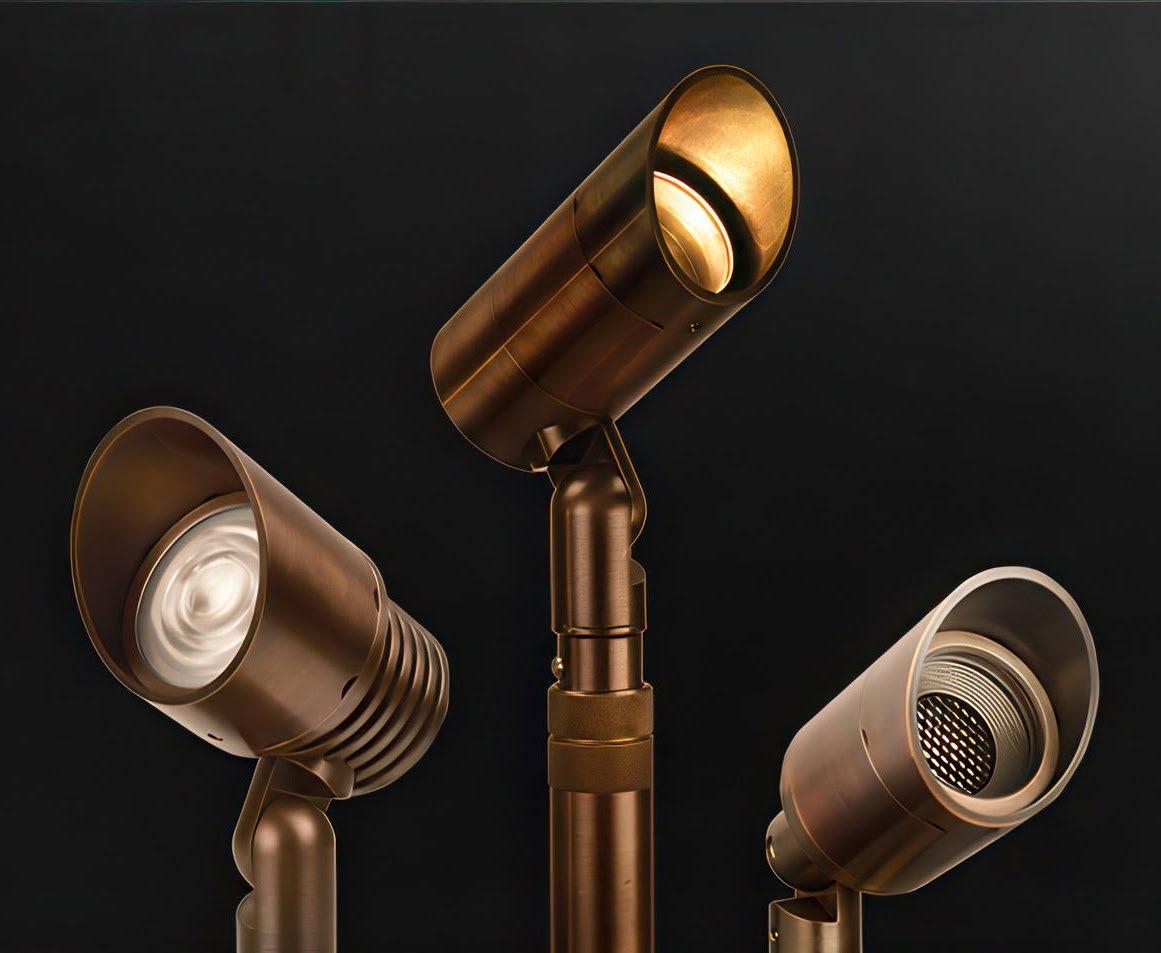








Introducing the Crestron Cevo Mini Remote — simply irresistible

In today’s technology-packed smart homes, simplicity is the definitive luxury. But simple doesn’t mean limited — it means focused. Our all-new Cevo Mini Remote delivers effortless entertainment and environment control in a smaller, ergonomically designed package you’ll want to hold onto. Experience the ease of fewer buttons, an intelligent layout, and direct access to the shortcuts you use every day. Try one and see what refined design feels like in your hand.





